Business and Business Environment
VerifiedAdded on 2023/06/18
|17
|6242
|249
AI Summary
This report discusses the meaning of business environment and its impact on IKEA. It presents different types of organizations, their size and scope, and the interrelationship between different organizational structures. It also evaluates the positive and negative factors of macro environment factors affecting IKEA.
Contribute Materials
Your contribution can guide someone’s learning journey. Share your
documents today.
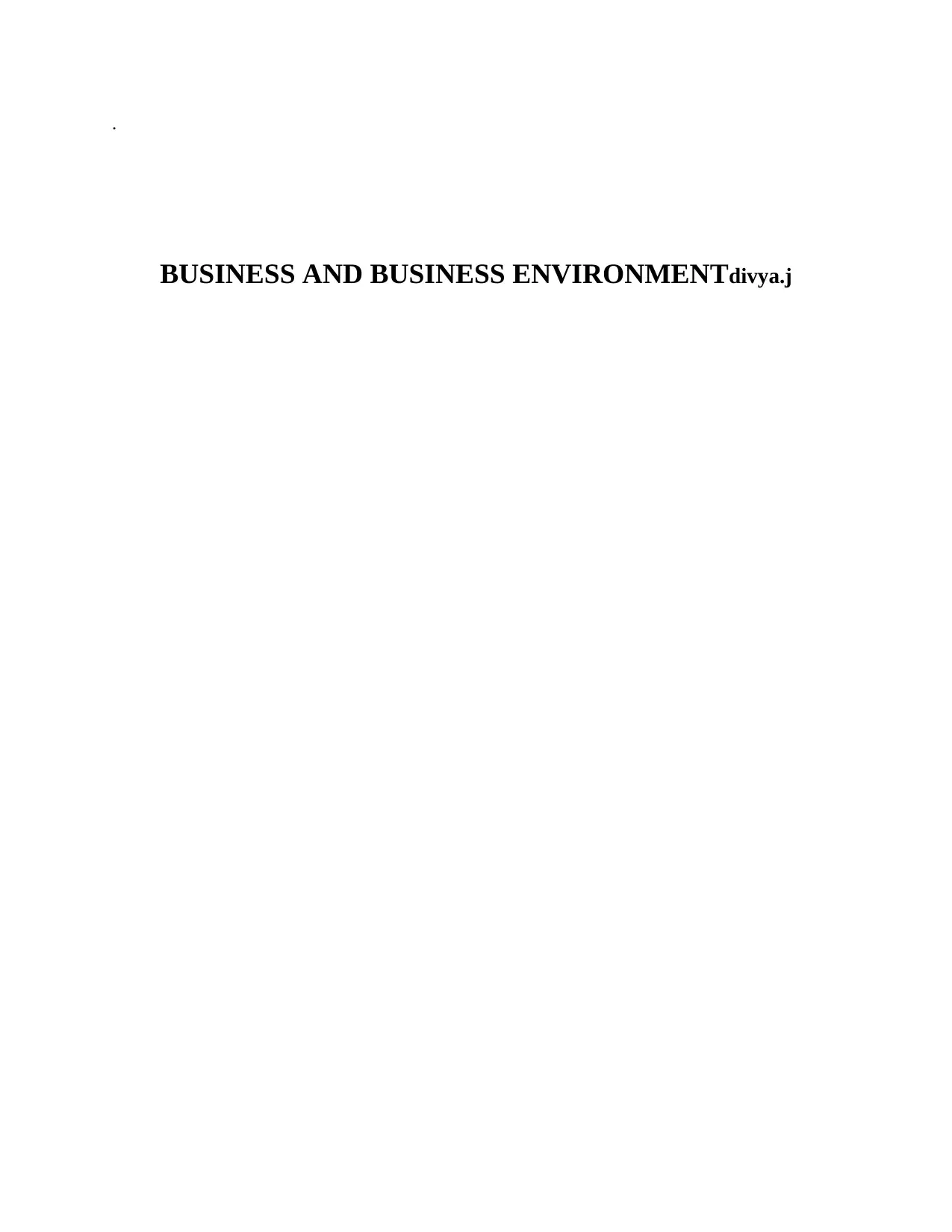
.
BUSINESS AND BUSINESS ENVIRONMENTdivya.j
BUSINESS AND BUSINESS ENVIRONMENTdivya.j
Secure Best Marks with AI Grader
Need help grading? Try our AI Grader for instant feedback on your assignments.
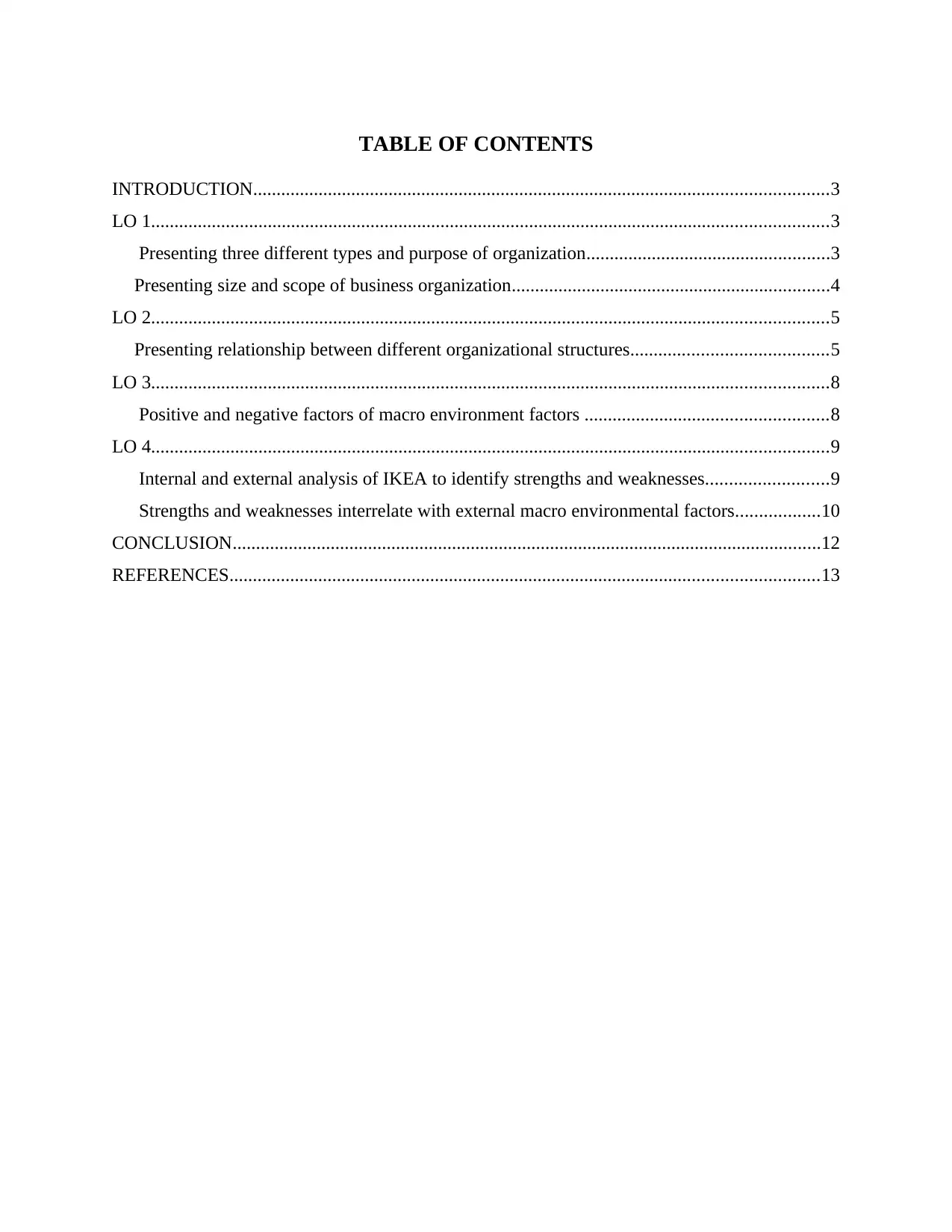
TABLE OF CONTENTS
INTRODUCTION...........................................................................................................................3
LO 1.................................................................................................................................................3
Presenting three different types and purpose of organization....................................................3
Presenting size and scope of business organization....................................................................4
LO 2.................................................................................................................................................5
Presenting relationship between different organizational structures..........................................5
LO 3.................................................................................................................................................8
Positive and negative factors of macro environment factors ....................................................8
LO 4.................................................................................................................................................9
Internal and external analysis of IKEA to identify strengths and weaknesses..........................9
Strengths and weaknesses interrelate with external macro environmental factors..................10
CONCLUSION..............................................................................................................................12
REFERENCES..............................................................................................................................13
INTRODUCTION...........................................................................................................................3
LO 1.................................................................................................................................................3
Presenting three different types and purpose of organization....................................................3
Presenting size and scope of business organization....................................................................4
LO 2.................................................................................................................................................5
Presenting relationship between different organizational structures..........................................5
LO 3.................................................................................................................................................8
Positive and negative factors of macro environment factors ....................................................8
LO 4.................................................................................................................................................9
Internal and external analysis of IKEA to identify strengths and weaknesses..........................9
Strengths and weaknesses interrelate with external macro environmental factors..................10
CONCLUSION..............................................................................................................................12
REFERENCES..............................................................................................................................13
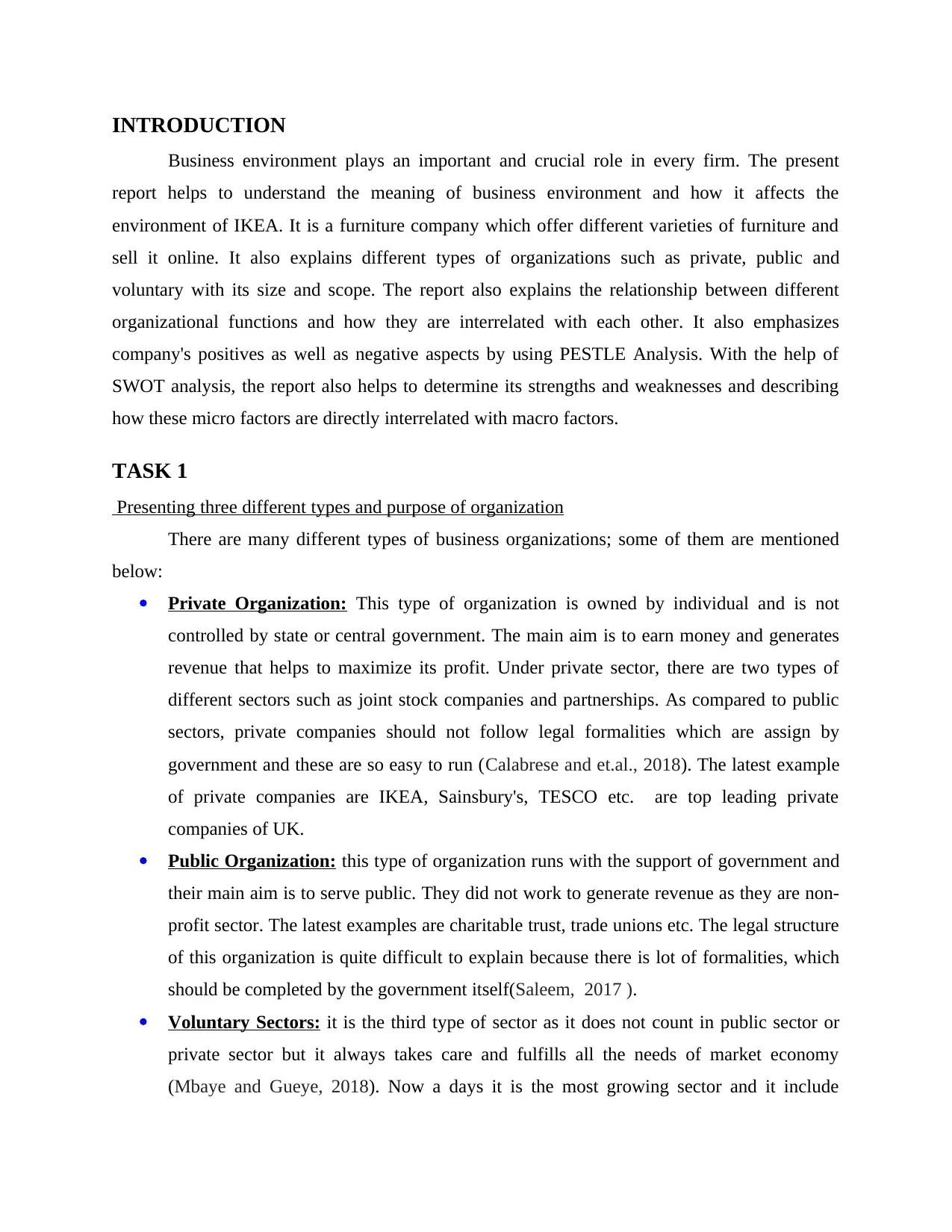
INTRODUCTION
Business environment plays an important and crucial role in every firm. The present
report helps to understand the meaning of business environment and how it affects the
environment of IKEA. It is a furniture company which offer different varieties of furniture and
sell it online. It also explains different types of organizations such as private, public and
voluntary with its size and scope. The report also explains the relationship between different
organizational functions and how they are interrelated with each other. It also emphasizes
company's positives as well as negative aspects by using PESTLE Analysis. With the help of
SWOT analysis, the report also helps to determine its strengths and weaknesses and describing
how these micro factors are directly interrelated with macro factors.
TASK 1
Presenting three different types and purpose of organization
There are many different types of business organizations; some of them are mentioned
below:
Private Organization: This type of organization is owned by individual and is not
controlled by state or central government. The main aim is to earn money and generates
revenue that helps to maximize its profit. Under private sector, there are two types of
different sectors such as joint stock companies and partnerships. As compared to public
sectors, private companies should not follow legal formalities which are assign by
government and these are so easy to run (Calabrese and et.al., 2018). The latest example
of private companies are IKEA, Sainsbury's, TESCO etc. are top leading private
companies of UK.
Public Organization: this type of organization runs with the support of government and
their main aim is to serve public. They did not work to generate revenue as they are non-
profit sector. The latest examples are charitable trust, trade unions etc. The legal structure
of this organization is quite difficult to explain because there is lot of formalities, which
should be completed by the government itself(Saleem, 2017 ).
Voluntary Sectors: it is the third type of sector as it does not count in public sector or
private sector but it always takes care and fulfills all the needs of market economy
(Mbaye and Gueye, 2018). Now a days it is the most growing sector and it include
Business environment plays an important and crucial role in every firm. The present
report helps to understand the meaning of business environment and how it affects the
environment of IKEA. It is a furniture company which offer different varieties of furniture and
sell it online. It also explains different types of organizations such as private, public and
voluntary with its size and scope. The report also explains the relationship between different
organizational functions and how they are interrelated with each other. It also emphasizes
company's positives as well as negative aspects by using PESTLE Analysis. With the help of
SWOT analysis, the report also helps to determine its strengths and weaknesses and describing
how these micro factors are directly interrelated with macro factors.
TASK 1
Presenting three different types and purpose of organization
There are many different types of business organizations; some of them are mentioned
below:
Private Organization: This type of organization is owned by individual and is not
controlled by state or central government. The main aim is to earn money and generates
revenue that helps to maximize its profit. Under private sector, there are two types of
different sectors such as joint stock companies and partnerships. As compared to public
sectors, private companies should not follow legal formalities which are assign by
government and these are so easy to run (Calabrese and et.al., 2018). The latest example
of private companies are IKEA, Sainsbury's, TESCO etc. are top leading private
companies of UK.
Public Organization: this type of organization runs with the support of government and
their main aim is to serve public. They did not work to generate revenue as they are non-
profit sector. The latest examples are charitable trust, trade unions etc. The legal structure
of this organization is quite difficult to explain because there is lot of formalities, which
should be completed by the government itself(Saleem, 2017 ).
Voluntary Sectors: it is the third type of sector as it does not count in public sector or
private sector but it always takes care and fulfills all the needs of market economy
(Mbaye and Gueye, 2018). Now a days it is the most growing sector and it include
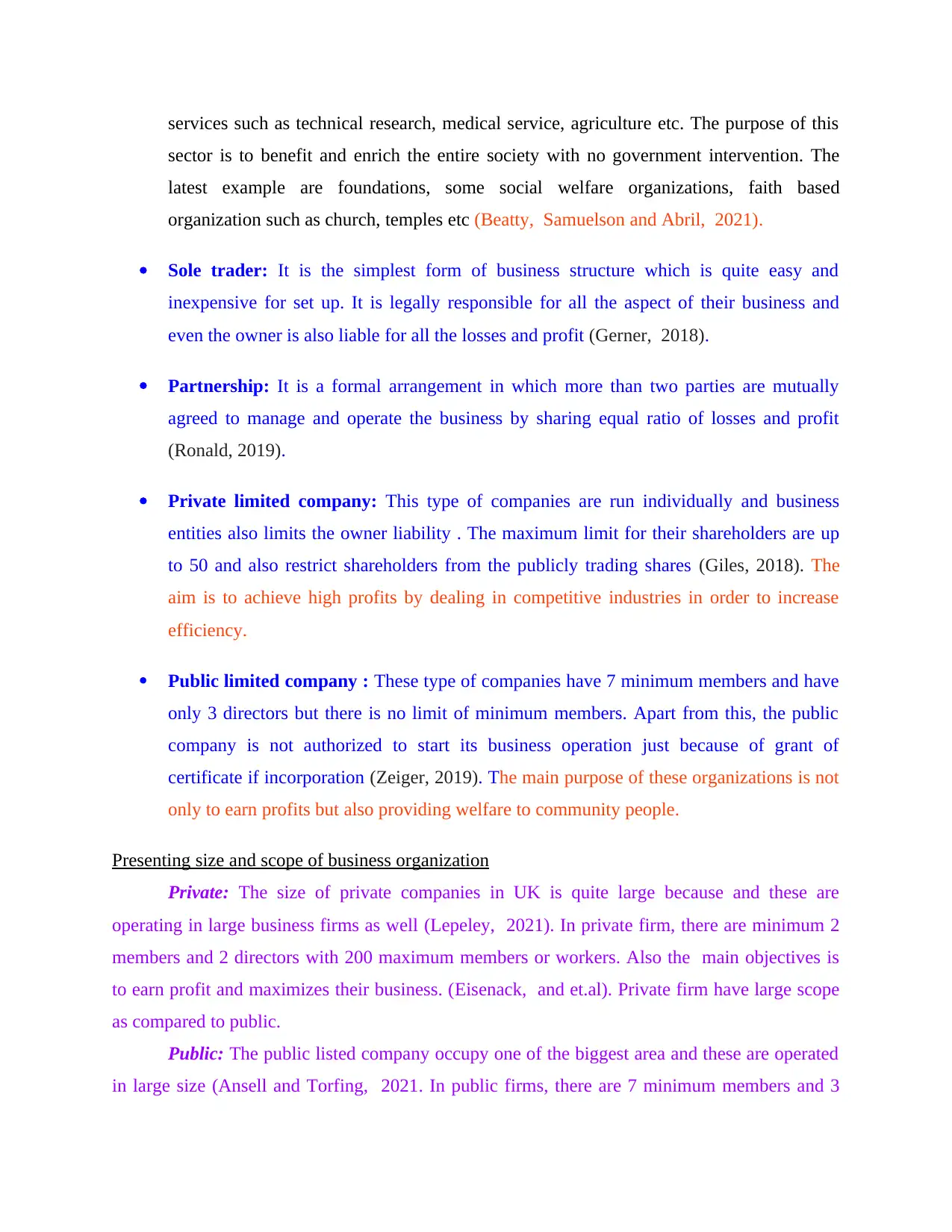
services such as technical research, medical service, agriculture etc. The purpose of this
sector is to benefit and enrich the entire society with no government intervention. The
latest example are foundations, some social welfare organizations, faith based
organization such as church, temples etc (Beatty, Samuelson and Abril, 2021).
Sole trader: It is the simplest form of business structure which is quite easy and
inexpensive for set up. It is legally responsible for all the aspect of their business and
even the owner is also liable for all the losses and profit (Gerner, 2018).
Partnership: It is a formal arrangement in which more than two parties are mutually
agreed to manage and operate the business by sharing equal ratio of losses and profit
(Ronald, 2019).
Private limited company: This type of companies are run individually and business
entities also limits the owner liability . The maximum limit for their shareholders are up
to 50 and also restrict shareholders from the publicly trading shares (Giles, 2018). The
aim is to achieve high profits by dealing in competitive industries in order to increase
efficiency.
Public limited company : These type of companies have 7 minimum members and have
only 3 directors but there is no limit of minimum members. Apart from this, the public
company is not authorized to start its business operation just because of grant of
certificate if incorporation (Zeiger, 2019). The main purpose of these organizations is not
only to earn profits but also providing welfare to community people.
Presenting size and scope of business organization
Private: The size of private companies in UK is quite large because and these are
operating in large business firms as well (Lepeley, 2021). In private firm, there are minimum 2
members and 2 directors with 200 maximum members or workers. Also the main objectives is
to earn profit and maximizes their business. (Eisenack, and et.al). Private firm have large scope
as compared to public.
Public: The public listed company occupy one of the biggest area and these are operated
in large size (Ansell and Torfing, 2021. In public firms, there are 7 minimum members and 3
sector is to benefit and enrich the entire society with no government intervention. The
latest example are foundations, some social welfare organizations, faith based
organization such as church, temples etc (Beatty, Samuelson and Abril, 2021).
Sole trader: It is the simplest form of business structure which is quite easy and
inexpensive for set up. It is legally responsible for all the aspect of their business and
even the owner is also liable for all the losses and profit (Gerner, 2018).
Partnership: It is a formal arrangement in which more than two parties are mutually
agreed to manage and operate the business by sharing equal ratio of losses and profit
(Ronald, 2019).
Private limited company: This type of companies are run individually and business
entities also limits the owner liability . The maximum limit for their shareholders are up
to 50 and also restrict shareholders from the publicly trading shares (Giles, 2018). The
aim is to achieve high profits by dealing in competitive industries in order to increase
efficiency.
Public limited company : These type of companies have 7 minimum members and have
only 3 directors but there is no limit of minimum members. Apart from this, the public
company is not authorized to start its business operation just because of grant of
certificate if incorporation (Zeiger, 2019). The main purpose of these organizations is not
only to earn profits but also providing welfare to community people.
Presenting size and scope of business organization
Private: The size of private companies in UK is quite large because and these are
operating in large business firms as well (Lepeley, 2021). In private firm, there are minimum 2
members and 2 directors with 200 maximum members or workers. Also the main objectives is
to earn profit and maximizes their business. (Eisenack, and et.al). Private firm have large scope
as compared to public.
Public: The public listed company occupy one of the biggest area and these are operated
in large size (Ansell and Torfing, 2021. In public firms, there are 7 minimum members and 3
Paraphrase This Document
Need a fresh take? Get an instant paraphrase of this document with our AI Paraphraser
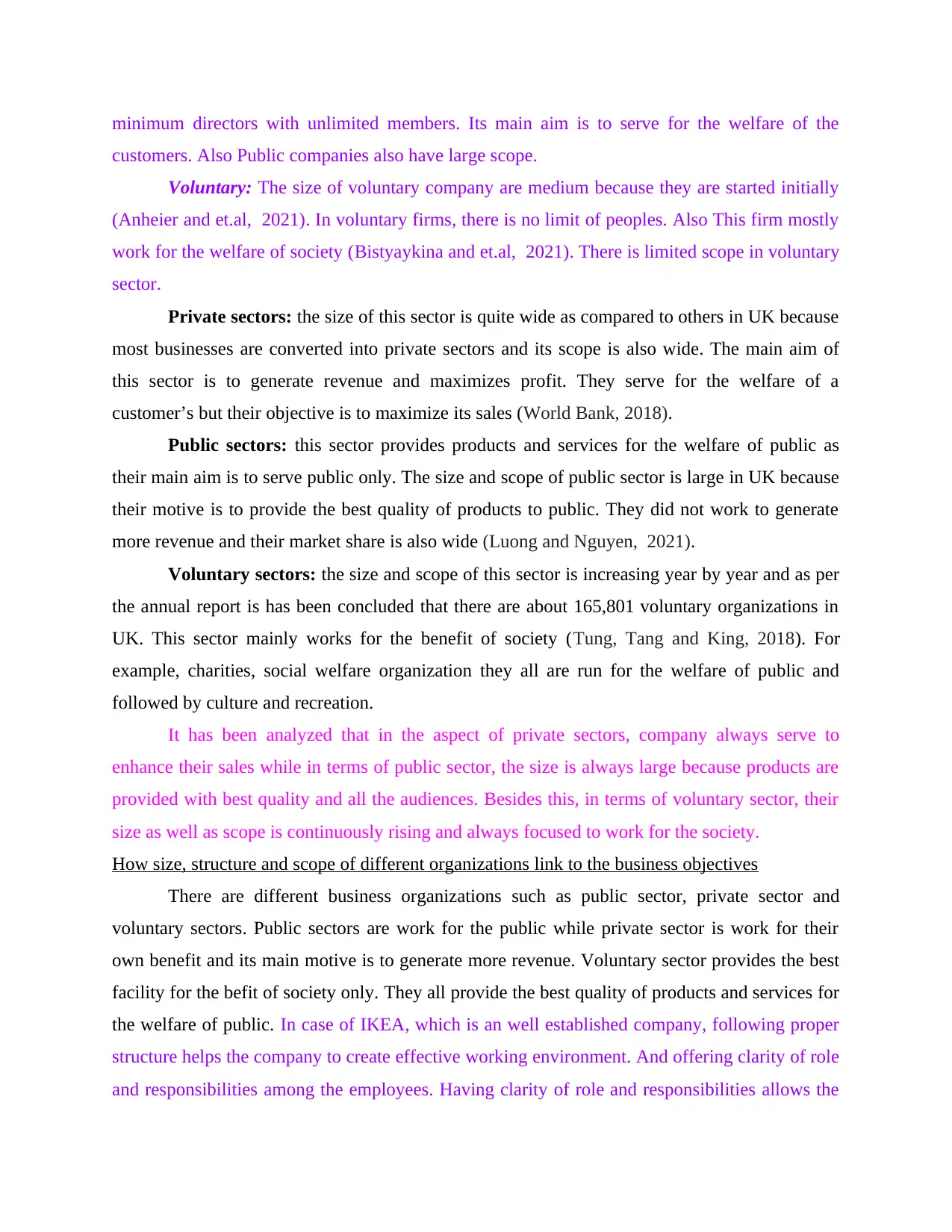
minimum directors with unlimited members. Its main aim is to serve for the welfare of the
customers. Also Public companies also have large scope.
Voluntary: The size of voluntary company are medium because they are started initially
(Anheier and et.al, 2021). In voluntary firms, there is no limit of peoples. Also This firm mostly
work for the welfare of society (Bistyaykina and et.al, 2021). There is limited scope in voluntary
sector.
Private sectors: the size of this sector is quite wide as compared to others in UK because
most businesses are converted into private sectors and its scope is also wide. The main aim of
this sector is to generate revenue and maximizes profit. They serve for the welfare of a
customer’s but their objective is to maximize its sales (World Bank, 2018).
Public sectors: this sector provides products and services for the welfare of public as
their main aim is to serve public only. The size and scope of public sector is large in UK because
their motive is to provide the best quality of products to public. They did not work to generate
more revenue and their market share is also wide (Luong and Nguyen, 2021).
Voluntary sectors: the size and scope of this sector is increasing year by year and as per
the annual report is has been concluded that there are about 165,801 voluntary organizations in
UK. This sector mainly works for the benefit of society (Tung, Tang and King, 2018). For
example, charities, social welfare organization they all are run for the welfare of public and
followed by culture and recreation.
It has been analyzed that in the aspect of private sectors, company always serve to
enhance their sales while in terms of public sector, the size is always large because products are
provided with best quality and all the audiences. Besides this, in terms of voluntary sector, their
size as well as scope is continuously rising and always focused to work for the society.
How size, structure and scope of different organizations link to the business objectives
There are different business organizations such as public sector, private sector and
voluntary sectors. Public sectors are work for the public while private sector is work for their
own benefit and its main motive is to generate more revenue. Voluntary sector provides the best
facility for the befit of society only. They all provide the best quality of products and services for
the welfare of public. In case of IKEA, which is an well established company, following proper
structure helps the company to create effective working environment. And offering clarity of role
and responsibilities among the employees. Having clarity of role and responsibilities allows the
customers. Also Public companies also have large scope.
Voluntary: The size of voluntary company are medium because they are started initially
(Anheier and et.al, 2021). In voluntary firms, there is no limit of peoples. Also This firm mostly
work for the welfare of society (Bistyaykina and et.al, 2021). There is limited scope in voluntary
sector.
Private sectors: the size of this sector is quite wide as compared to others in UK because
most businesses are converted into private sectors and its scope is also wide. The main aim of
this sector is to generate revenue and maximizes profit. They serve for the welfare of a
customer’s but their objective is to maximize its sales (World Bank, 2018).
Public sectors: this sector provides products and services for the welfare of public as
their main aim is to serve public only. The size and scope of public sector is large in UK because
their motive is to provide the best quality of products to public. They did not work to generate
more revenue and their market share is also wide (Luong and Nguyen, 2021).
Voluntary sectors: the size and scope of this sector is increasing year by year and as per
the annual report is has been concluded that there are about 165,801 voluntary organizations in
UK. This sector mainly works for the benefit of society (Tung, Tang and King, 2018). For
example, charities, social welfare organization they all are run for the welfare of public and
followed by culture and recreation.
It has been analyzed that in the aspect of private sectors, company always serve to
enhance their sales while in terms of public sector, the size is always large because products are
provided with best quality and all the audiences. Besides this, in terms of voluntary sector, their
size as well as scope is continuously rising and always focused to work for the society.
How size, structure and scope of different organizations link to the business objectives
There are different business organizations such as public sector, private sector and
voluntary sectors. Public sectors are work for the public while private sector is work for their
own benefit and its main motive is to generate more revenue. Voluntary sector provides the best
facility for the befit of society only. They all provide the best quality of products and services for
the welfare of public. In case of IKEA, which is an well established company, following proper
structure helps the company to create effective working environment. And offering clarity of role
and responsibilities among the employees. Having clarity of role and responsibilities allows the
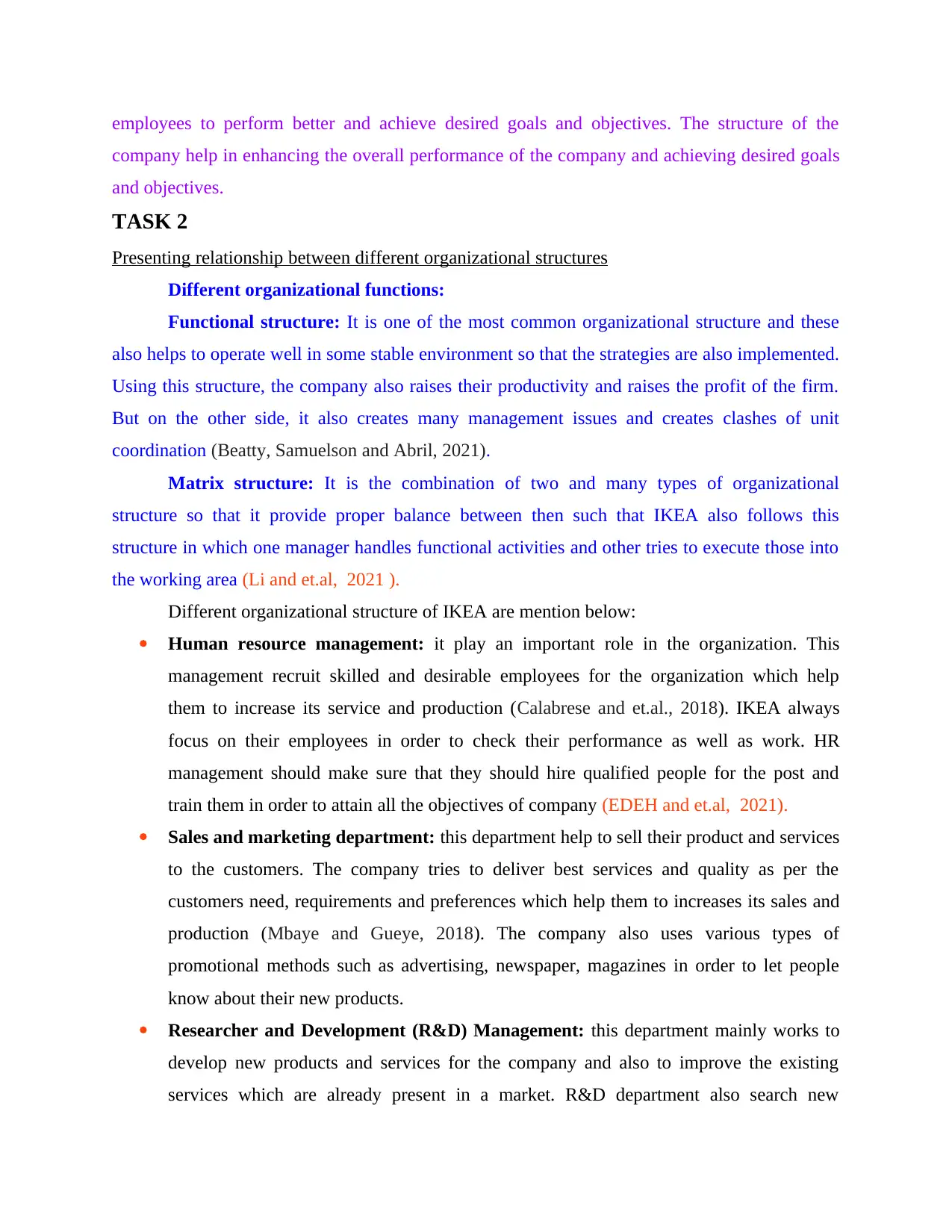
employees to perform better and achieve desired goals and objectives. The structure of the
company help in enhancing the overall performance of the company and achieving desired goals
and objectives.
TASK 2
Presenting relationship between different organizational structures
Different organizational functions:
Functional structure: It is one of the most common organizational structure and these
also helps to operate well in some stable environment so that the strategies are also implemented.
Using this structure, the company also raises their productivity and raises the profit of the firm.
But on the other side, it also creates many management issues and creates clashes of unit
coordination (Beatty, Samuelson and Abril, 2021).
Matrix structure: It is the combination of two and many types of organizational
structure so that it provide proper balance between then such that IKEA also follows this
structure in which one manager handles functional activities and other tries to execute those into
the working area (Li and et.al, 2021 ).
Different organizational structure of IKEA are mention below:
Human resource management: it play an important role in the organization. This
management recruit skilled and desirable employees for the organization which help
them to increase its service and production (Calabrese and et.al., 2018). IKEA always
focus on their employees in order to check their performance as well as work. HR
management should make sure that they should hire qualified people for the post and
train them in order to attain all the objectives of company (EDEH and et.al, 2021).
Sales and marketing department: this department help to sell their product and services
to the customers. The company tries to deliver best services and quality as per the
customers need, requirements and preferences which help them to increases its sales and
production (Mbaye and Gueye, 2018). The company also uses various types of
promotional methods such as advertising, newspaper, magazines in order to let people
know about their new products.
Researcher and Development (R&D) Management: this department mainly works to
develop new products and services for the company and also to improve the existing
services which are already present in a market. R&D department also search new
company help in enhancing the overall performance of the company and achieving desired goals
and objectives.
TASK 2
Presenting relationship between different organizational structures
Different organizational functions:
Functional structure: It is one of the most common organizational structure and these
also helps to operate well in some stable environment so that the strategies are also implemented.
Using this structure, the company also raises their productivity and raises the profit of the firm.
But on the other side, it also creates many management issues and creates clashes of unit
coordination (Beatty, Samuelson and Abril, 2021).
Matrix structure: It is the combination of two and many types of organizational
structure so that it provide proper balance between then such that IKEA also follows this
structure in which one manager handles functional activities and other tries to execute those into
the working area (Li and et.al, 2021 ).
Different organizational structure of IKEA are mention below:
Human resource management: it play an important role in the organization. This
management recruit skilled and desirable employees for the organization which help
them to increase its service and production (Calabrese and et.al., 2018). IKEA always
focus on their employees in order to check their performance as well as work. HR
management should make sure that they should hire qualified people for the post and
train them in order to attain all the objectives of company (EDEH and et.al, 2021).
Sales and marketing department: this department help to sell their product and services
to the customers. The company tries to deliver best services and quality as per the
customers need, requirements and preferences which help them to increases its sales and
production (Mbaye and Gueye, 2018). The company also uses various types of
promotional methods such as advertising, newspaper, magazines in order to let people
know about their new products.
Researcher and Development (R&D) Management: this department mainly works to
develop new products and services for the company and also to improve the existing
services which are already present in a market. R&D department also search new
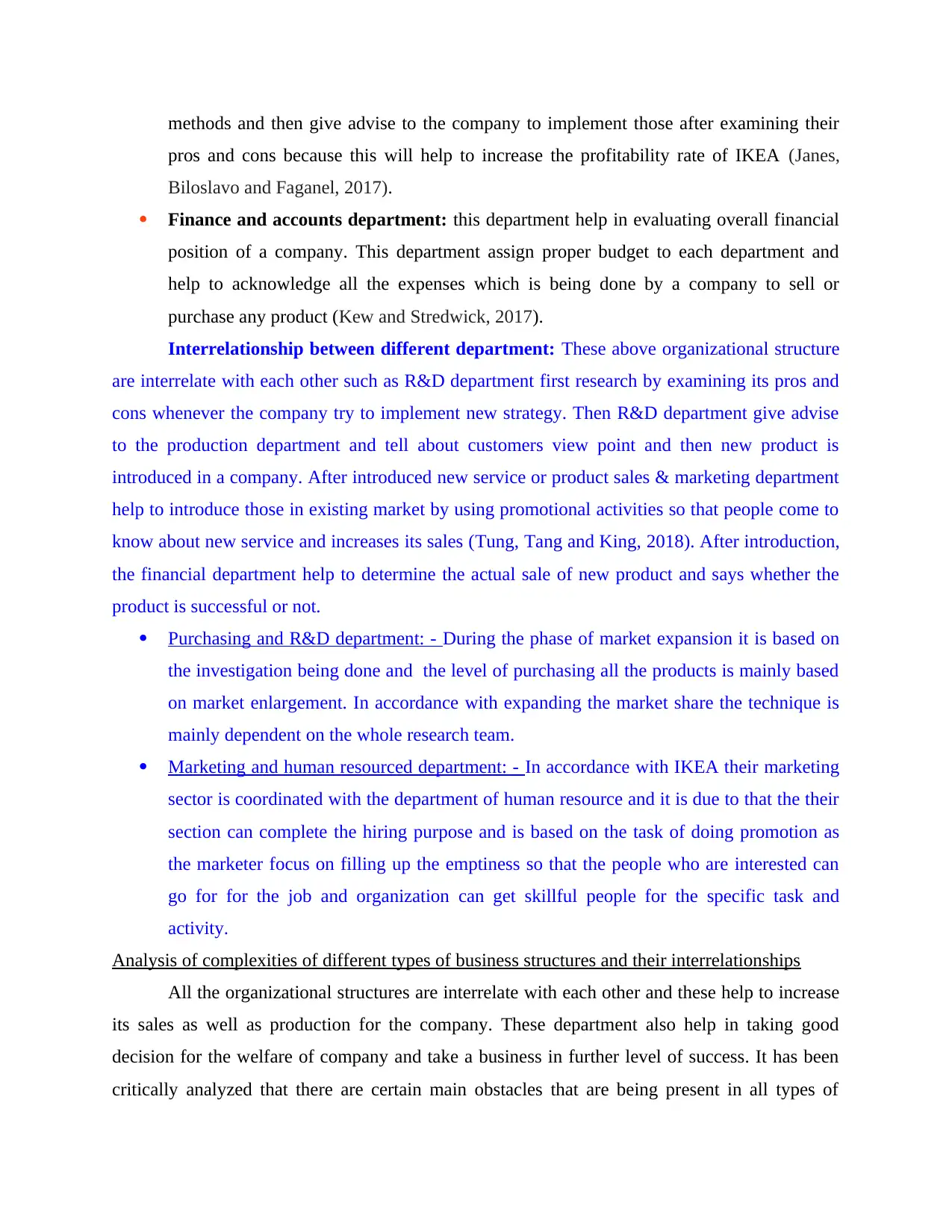
methods and then give advise to the company to implement those after examining their
pros and cons because this will help to increase the profitability rate of IKEA (Janes,
Biloslavo and Faganel, 2017).
Finance and accounts department: this department help in evaluating overall financial
position of a company. This department assign proper budget to each department and
help to acknowledge all the expenses which is being done by a company to sell or
purchase any product (Kew and Stredwick, 2017).
Interrelationship between different department: These above organizational structure
are interrelate with each other such as R&D department first research by examining its pros and
cons whenever the company try to implement new strategy. Then R&D department give advise
to the production department and tell about customers view point and then new product is
introduced in a company. After introduced new service or product sales & marketing department
help to introduce those in existing market by using promotional activities so that people come to
know about new service and increases its sales (Tung, Tang and King, 2018). After introduction,
the financial department help to determine the actual sale of new product and says whether the
product is successful or not.
Purchasing and R&D department: - During the phase of market expansion it is based on
the investigation being done and the level of purchasing all the products is mainly based
on market enlargement. In accordance with expanding the market share the technique is
mainly dependent on the whole research team.
Marketing and human resourced department: - In accordance with IKEA their marketing
sector is coordinated with the department of human resource and it is due to that the their
section can complete the hiring purpose and is based on the task of doing promotion as
the marketer focus on filling up the emptiness so that the people who are interested can
go for for the job and organization can get skillful people for the specific task and
activity.
Analysis of complexities of different types of business structures and their interrelationships
All the organizational structures are interrelate with each other and these help to increase
its sales as well as production for the company. These department also help in taking good
decision for the welfare of company and take a business in further level of success. It has been
critically analyzed that there are certain main obstacles that are being present in all types of
pros and cons because this will help to increase the profitability rate of IKEA (Janes,
Biloslavo and Faganel, 2017).
Finance and accounts department: this department help in evaluating overall financial
position of a company. This department assign proper budget to each department and
help to acknowledge all the expenses which is being done by a company to sell or
purchase any product (Kew and Stredwick, 2017).
Interrelationship between different department: These above organizational structure
are interrelate with each other such as R&D department first research by examining its pros and
cons whenever the company try to implement new strategy. Then R&D department give advise
to the production department and tell about customers view point and then new product is
introduced in a company. After introduced new service or product sales & marketing department
help to introduce those in existing market by using promotional activities so that people come to
know about new service and increases its sales (Tung, Tang and King, 2018). After introduction,
the financial department help to determine the actual sale of new product and says whether the
product is successful or not.
Purchasing and R&D department: - During the phase of market expansion it is based on
the investigation being done and the level of purchasing all the products is mainly based
on market enlargement. In accordance with expanding the market share the technique is
mainly dependent on the whole research team.
Marketing and human resourced department: - In accordance with IKEA their marketing
sector is coordinated with the department of human resource and it is due to that the their
section can complete the hiring purpose and is based on the task of doing promotion as
the marketer focus on filling up the emptiness so that the people who are interested can
go for for the job and organization can get skillful people for the specific task and
activity.
Analysis of complexities of different types of business structures and their interrelationships
All the organizational structures are interrelate with each other and these help to increase
its sales as well as production for the company. These department also help in taking good
decision for the welfare of company and take a business in further level of success. It has been
critically analyzed that there are certain main obstacles that are being present in all types of
Secure Best Marks with AI Grader
Need help grading? Try our AI Grader for instant feedback on your assignments.

organizational structures like misinterpretation due to which outcomes don't get achieved as per
the time being set. There are several number of tasks that are being present and in context with
that it becomes very challenging to evaluate which is the most important (Mierau, Soloveva and
Popov, 2020)
TASK 3
Positive and negative factors of macro environment factors
Macro environmental factors are external factors that affects the outer environment and
internal as well. This factor can be evaluated by using PESTLE analysis and helps IKEA to
understand its positive as well as negative factors and these are mentioned below:
Political Factor: Political factor generally includes sudden change in the rules and
regulations of the government that should be implemented in other business but a company like
IKEA who operates 40 stores worldwide might find it difficult to follow such rules. Due to this
factor, sales and profits both are affected (Balasubramanian, 2017).
Positive impact: following all the political policies will helps the company to function
effectively.
Negative impact: Any kind of changes in the political condition will directly influence the
operation of the business such as changes in the brexit
Economic Factor: for MNC’s, global recession is one of the biggest challenges and
economic factor affect both revenue as well as profit of IKEA. As the company manages its
price so well and as a result was least affected by recession. Sudden fluctuation in economy of
country also affect IKEA's profit. The economic condition of market is another factor that affects
the pricing policies of an organization (Mols and Jetten, 2017).
Positive impact: Working in the well developed economy will help the company to enhance
their overall profitability and productivity.
Negative impact: Any kind of fluctuation in the economy will lead to directly influencing the
operation of the company.
Social Factor: the company always provides its best product and facility to society. Even
it also promises to provide the best stylish and high quality of furniture at low and affordable
prices to their customers. The company also attracts some social group of customers who
belongs to different culture and societies and always try to fulfill all the need and requirements of
their customers (Pilgrim and Rogers, 2018).
the time being set. There are several number of tasks that are being present and in context with
that it becomes very challenging to evaluate which is the most important (Mierau, Soloveva and
Popov, 2020)
TASK 3
Positive and negative factors of macro environment factors
Macro environmental factors are external factors that affects the outer environment and
internal as well. This factor can be evaluated by using PESTLE analysis and helps IKEA to
understand its positive as well as negative factors and these are mentioned below:
Political Factor: Political factor generally includes sudden change in the rules and
regulations of the government that should be implemented in other business but a company like
IKEA who operates 40 stores worldwide might find it difficult to follow such rules. Due to this
factor, sales and profits both are affected (Balasubramanian, 2017).
Positive impact: following all the political policies will helps the company to function
effectively.
Negative impact: Any kind of changes in the political condition will directly influence the
operation of the business such as changes in the brexit
Economic Factor: for MNC’s, global recession is one of the biggest challenges and
economic factor affect both revenue as well as profit of IKEA. As the company manages its
price so well and as a result was least affected by recession. Sudden fluctuation in economy of
country also affect IKEA's profit. The economic condition of market is another factor that affects
the pricing policies of an organization (Mols and Jetten, 2017).
Positive impact: Working in the well developed economy will help the company to enhance
their overall profitability and productivity.
Negative impact: Any kind of fluctuation in the economy will lead to directly influencing the
operation of the company.
Social Factor: the company always provides its best product and facility to society. Even
it also promises to provide the best stylish and high quality of furniture at low and affordable
prices to their customers. The company also attracts some social group of customers who
belongs to different culture and societies and always try to fulfill all the need and requirements of
their customers (Pilgrim and Rogers, 2018).
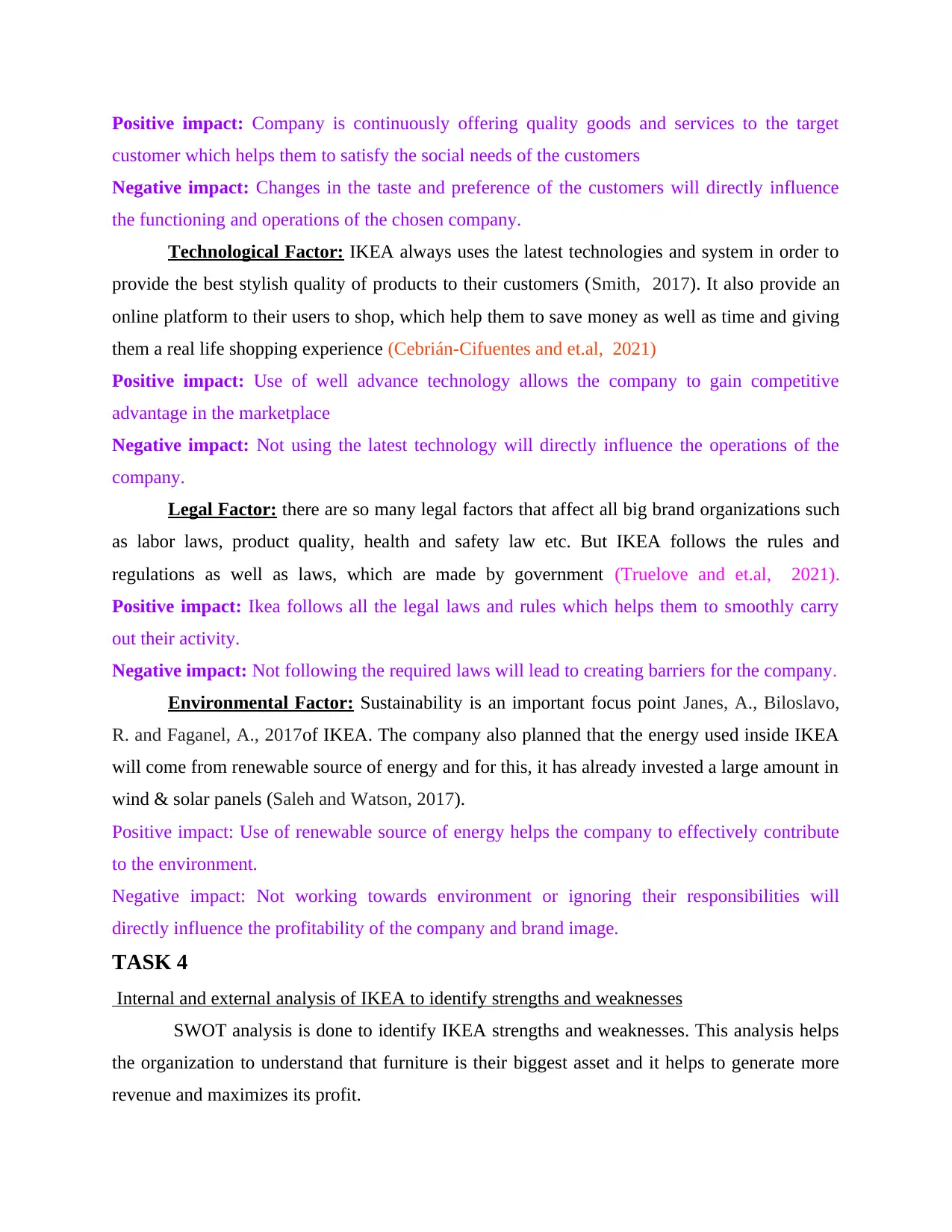
Positive impact: Company is continuously offering quality goods and services to the target
customer which helps them to satisfy the social needs of the customers
Negative impact: Changes in the taste and preference of the customers will directly influence
the functioning and operations of the chosen company.
Technological Factor: IKEA always uses the latest technologies and system in order to
provide the best stylish quality of products to their customers (Smith, 2017). It also provide an
online platform to their users to shop, which help them to save money as well as time and giving
them a real life shopping experience (Cebrián-Cifuentes and et.al, 2021)
Positive impact: Use of well advance technology allows the company to gain competitive
advantage in the marketplace
Negative impact: Not using the latest technology will directly influence the operations of the
company.
Legal Factor: there are so many legal factors that affect all big brand organizations such
as labor laws, product quality, health and safety law etc. But IKEA follows the rules and
regulations as well as laws, which are made by government (Truelove and et.al, 2021).
Positive impact: Ikea follows all the legal laws and rules which helps them to smoothly carry
out their activity.
Negative impact: Not following the required laws will lead to creating barriers for the company.
Environmental Factor: Sustainability is an important focus point Janes, A., Biloslavo,
R. and Faganel, A., 2017of IKEA. The company also planned that the energy used inside IKEA
will come from renewable source of energy and for this, it has already invested a large amount in
wind & solar panels (Saleh and Watson, 2017).
Positive impact: Use of renewable source of energy helps the company to effectively contribute
to the environment.
Negative impact: Not working towards environment or ignoring their responsibilities will
directly influence the profitability of the company and brand image.
TASK 4
Internal and external analysis of IKEA to identify strengths and weaknesses
SWOT analysis is done to identify IKEA strengths and weaknesses. This analysis helps
the organization to understand that furniture is their biggest asset and it helps to generate more
revenue and maximizes its profit.
customer which helps them to satisfy the social needs of the customers
Negative impact: Changes in the taste and preference of the customers will directly influence
the functioning and operations of the chosen company.
Technological Factor: IKEA always uses the latest technologies and system in order to
provide the best stylish quality of products to their customers (Smith, 2017). It also provide an
online platform to their users to shop, which help them to save money as well as time and giving
them a real life shopping experience (Cebrián-Cifuentes and et.al, 2021)
Positive impact: Use of well advance technology allows the company to gain competitive
advantage in the marketplace
Negative impact: Not using the latest technology will directly influence the operations of the
company.
Legal Factor: there are so many legal factors that affect all big brand organizations such
as labor laws, product quality, health and safety law etc. But IKEA follows the rules and
regulations as well as laws, which are made by government (Truelove and et.al, 2021).
Positive impact: Ikea follows all the legal laws and rules which helps them to smoothly carry
out their activity.
Negative impact: Not following the required laws will lead to creating barriers for the company.
Environmental Factor: Sustainability is an important focus point Janes, A., Biloslavo,
R. and Faganel, A., 2017of IKEA. The company also planned that the energy used inside IKEA
will come from renewable source of energy and for this, it has already invested a large amount in
wind & solar panels (Saleh and Watson, 2017).
Positive impact: Use of renewable source of energy helps the company to effectively contribute
to the environment.
Negative impact: Not working towards environment or ignoring their responsibilities will
directly influence the profitability of the company and brand image.
TASK 4
Internal and external analysis of IKEA to identify strengths and weaknesses
SWOT analysis is done to identify IKEA strengths and weaknesses. This analysis helps
the organization to understand that furniture is their biggest asset and it helps to generate more
revenue and maximizes its profit.

Strengths: the company provides the best and stylish quality furniture at low and
affordable prices to their customers. The company also has its brand image and excellent
product design who offer in online mode to save money as well as time of people. The
company has variety of design in their product range, which makes them unique in the
target industry (SWOT analysis of IKEA, 2018). Even the company has strong financial
position as well as strong revenue growth.
Weaknesses: the greatest weakness of IKEA is their performance in the Asian market
where the company is not up to mark. The company provides its innovative products and
there is a need to diversify its product range as per the local taste, which will not only
help to attract lots of customer but also increase the competition in market (Benzaghta
and et.al, 2021).
Opportunities: there is a huge scope of opportunities for IKEA. The company focuses
on “Green Business Model”, which helps to attract more customers and expand its
business at international level. They may also opt for strategic partnership with other
brands in order to promote their business (Komljenovic, Loiselle and Kumral, 2017).
Threats: The major threat, which a compa3_929682929ny faces, is the demand of
premium products with improved economic conditions. There is a huge competitive
pressure from the competitors’ brand, which makes IKEA unable to build a strong brand
in Asian markets (Zahra, Wahyudin and Nugraha, 2021).
SWOT analysis of Amazon
Strength Weaknesses
It is one of leading online retail
company in UK.
The firm uses cost leadership,
differentiation and focus cost strategy.
The firm has superior logistics and
distribution system that helps to attain
wide customers attention towards them.
There are many products which fail and
leads a business towards loss.
Company's operating margins are
remained weak from many times (Sari
and Subagyo, 2020).
Opportunities Threats
affordable prices to their customers. The company also has its brand image and excellent
product design who offer in online mode to save money as well as time of people. The
company has variety of design in their product range, which makes them unique in the
target industry (SWOT analysis of IKEA, 2018). Even the company has strong financial
position as well as strong revenue growth.
Weaknesses: the greatest weakness of IKEA is their performance in the Asian market
where the company is not up to mark. The company provides its innovative products and
there is a need to diversify its product range as per the local taste, which will not only
help to attract lots of customer but also increase the competition in market (Benzaghta
and et.al, 2021).
Opportunities: there is a huge scope of opportunities for IKEA. The company focuses
on “Green Business Model”, which helps to attract more customers and expand its
business at international level. They may also opt for strategic partnership with other
brands in order to promote their business (Komljenovic, Loiselle and Kumral, 2017).
Threats: The major threat, which a compa3_929682929ny faces, is the demand of
premium products with improved economic conditions. There is a huge competitive
pressure from the competitors’ brand, which makes IKEA unable to build a strong brand
in Asian markets (Zahra, Wahyudin and Nugraha, 2021).
SWOT analysis of Amazon
Strength Weaknesses
It is one of leading online retail
company in UK.
The firm uses cost leadership,
differentiation and focus cost strategy.
The firm has superior logistics and
distribution system that helps to attain
wide customers attention towards them.
There are many products which fail and
leads a business towards loss.
Company's operating margins are
remained weak from many times (Sari
and Subagyo, 2020).
Opportunities Threats
Paraphrase This Document
Need a fresh take? Get an instant paraphrase of this document with our AI Paraphraser
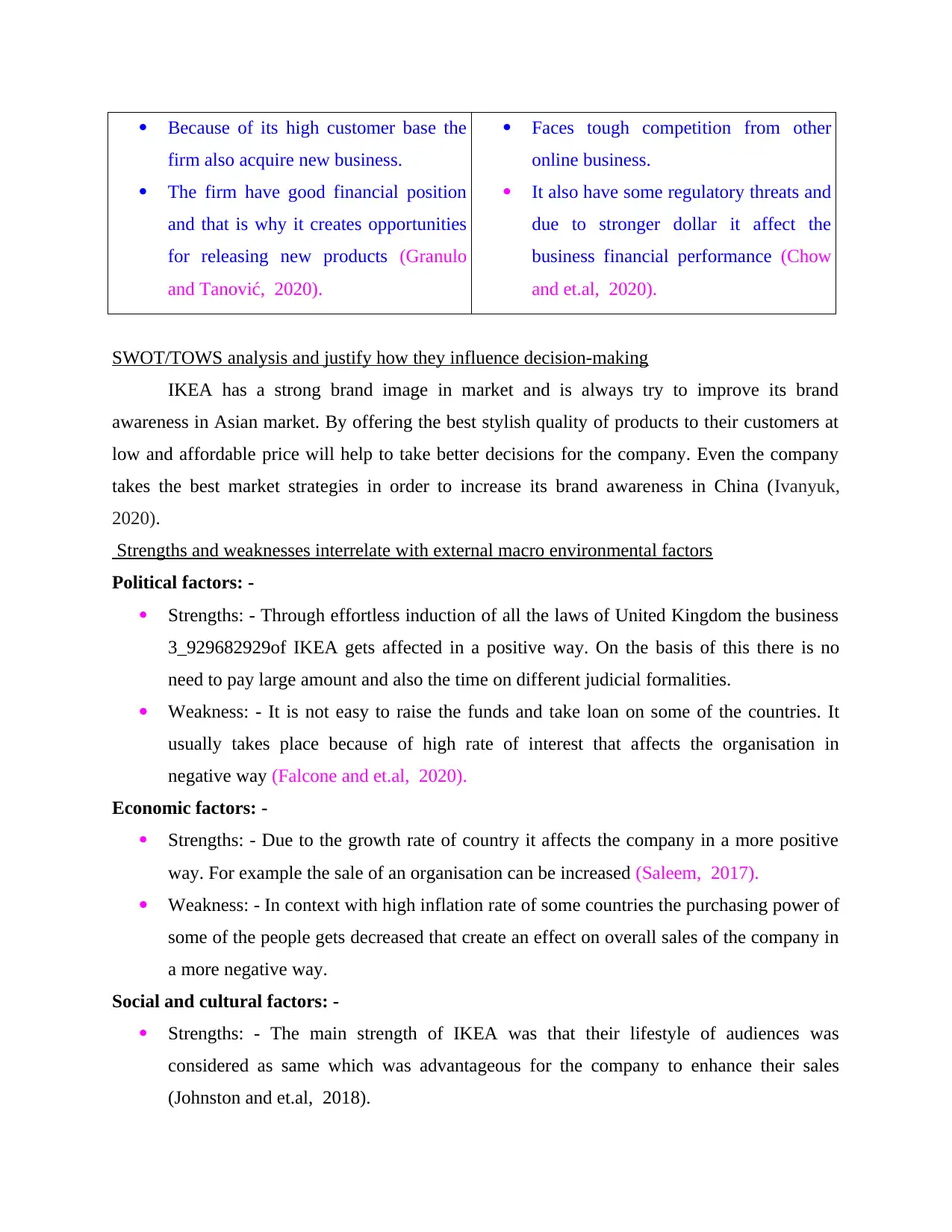
Because of its high customer base the
firm also acquire new business.
The firm have good financial position
and that is why it creates opportunities
for releasing new products (Granulo
and Tanović, 2020).
Faces tough competition from other
online business.
It also have some regulatory threats and
due to stronger dollar it affect the
business financial performance (Chow
and et.al, 2020).
SWOT/TOWS analysis and justify how they influence decision-making
IKEA has a strong brand image in market and is always try to improve its brand
awareness in Asian market. By offering the best stylish quality of products to their customers at
low and affordable price will help to take better decisions for the company. Even the company
takes the best market strategies in order to increase its brand awareness in China (Ivanyuk,
2020).
Strengths and weaknesses interrelate with external macro environmental factors
Political factors: -
Strengths: - Through effortless induction of all the laws of United Kingdom the business
3_929682929of IKEA gets affected in a positive way. On the basis of this there is no
need to pay large amount and also the time on different judicial formalities.
Weakness: - It is not easy to raise the funds and take loan on some of the countries. It
usually takes place because of high rate of interest that affects the organisation in
negative way (Falcone and et.al, 2020).
Economic factors: -
Strengths: - Due to the growth rate of country it affects the company in a more positive
way. For example the sale of an organisation can be increased (Saleem, 2017).
Weakness: - In context with high inflation rate of some countries the purchasing power of
some of the people gets decreased that create an effect on overall sales of the company in
a more negative way.
Social and cultural factors: -
Strengths: - The main strength of IKEA was that their lifestyle of audiences was
considered as same which was advantageous for the company to enhance their sales
(Johnston and et.al, 2018).
firm also acquire new business.
The firm have good financial position
and that is why it creates opportunities
for releasing new products (Granulo
and Tanović, 2020).
Faces tough competition from other
online business.
It also have some regulatory threats and
due to stronger dollar it affect the
business financial performance (Chow
and et.al, 2020).
SWOT/TOWS analysis and justify how they influence decision-making
IKEA has a strong brand image in market and is always try to improve its brand
awareness in Asian market. By offering the best stylish quality of products to their customers at
low and affordable price will help to take better decisions for the company. Even the company
takes the best market strategies in order to increase its brand awareness in China (Ivanyuk,
2020).
Strengths and weaknesses interrelate with external macro environmental factors
Political factors: -
Strengths: - Through effortless induction of all the laws of United Kingdom the business
3_929682929of IKEA gets affected in a positive way. On the basis of this there is no
need to pay large amount and also the time on different judicial formalities.
Weakness: - It is not easy to raise the funds and take loan on some of the countries. It
usually takes place because of high rate of interest that affects the organisation in
negative way (Falcone and et.al, 2020).
Economic factors: -
Strengths: - Due to the growth rate of country it affects the company in a more positive
way. For example the sale of an organisation can be increased (Saleem, 2017).
Weakness: - In context with high inflation rate of some countries the purchasing power of
some of the people gets decreased that create an effect on overall sales of the company in
a more negative way.
Social and cultural factors: -
Strengths: - The main strength of IKEA was that their lifestyle of audiences was
considered as same which was advantageous for the company to enhance their sales
(Johnston and et.al, 2018).
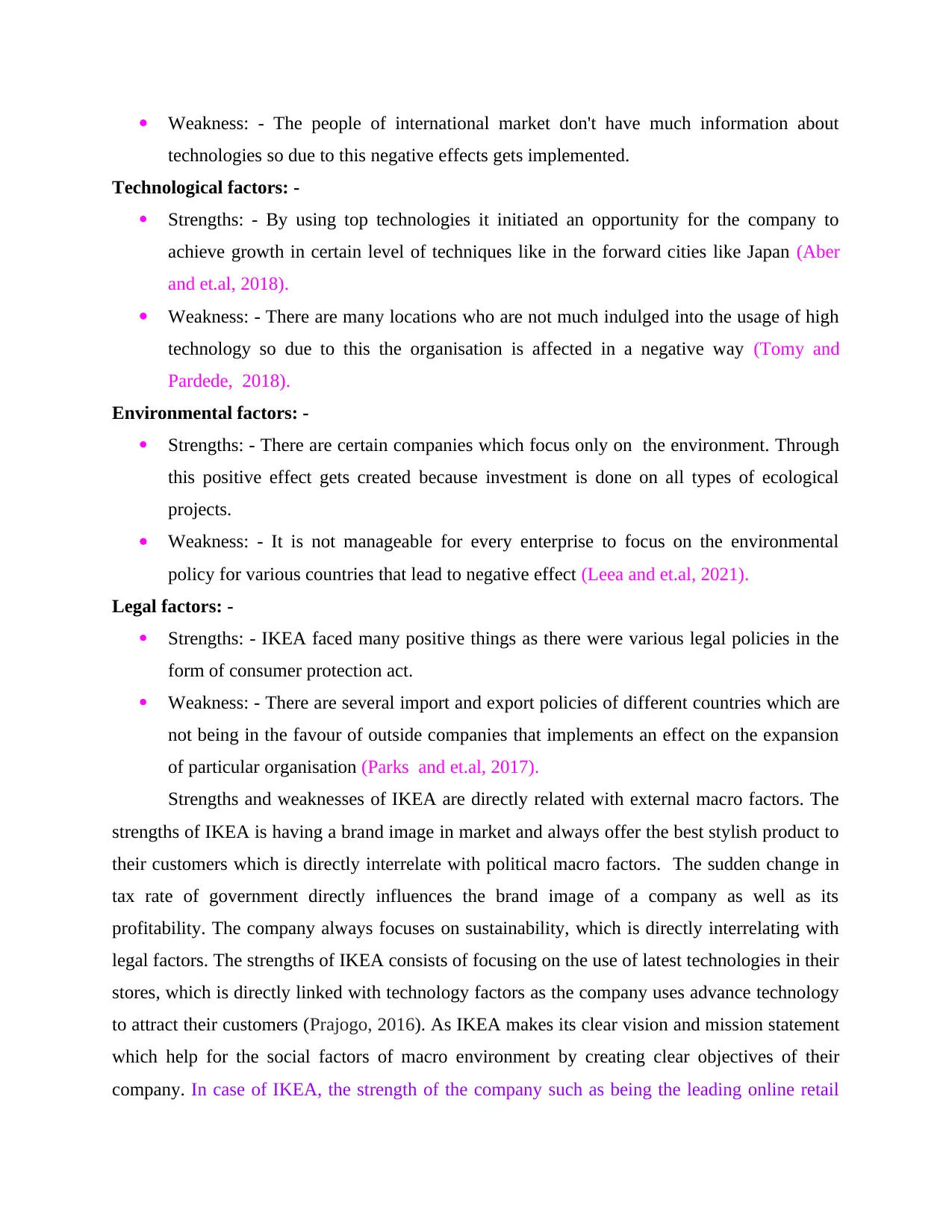
Weakness: - The people of international market don't have much information about
technologies so due to this negative effects gets implemented.
Technological factors: -
Strengths: - By using top technologies it initiated an opportunity for the company to
achieve growth in certain level of techniques like in the forward cities like Japan (Aber
and et.al, 2018).
Weakness: - There are many locations who are not much indulged into the usage of high
technology so due to this the organisation is affected in a negative way (Tomy and
Pardede, 2018).
Environmental factors: -
Strengths: - There are certain companies which focus only on the environment. Through
this positive effect gets created because investment is done on all types of ecological
projects.
Weakness: - It is not manageable for every enterprise to focus on the environmental
policy for various countries that lead to negative effect (Leea and et.al, 2021).
Legal factors: -
Strengths: - IKEA faced many positive things as there were various legal policies in the
form of consumer protection act.
Weakness: - There are several import and export policies of different countries which are
not being in the favour of outside companies that implements an effect on the expansion
of particular organisation (Parks and et.al, 2017).
Strengths and weaknesses of IKEA are directly related with external macro factors. The
strengths of IKEA is having a brand image in market and always offer the best stylish product to
their customers which is directly interrelate with political macro factors. The sudden change in
tax rate of government directly influences the brand image of a company as well as its
profitability. The company always focuses on sustainability, which is directly interrelating with
legal factors. The strengths of IKEA consists of focusing on the use of latest technologies in their
stores, which is directly linked with technology factors as the company uses advance technology
to attract their customers (Prajogo, 2016). As IKEA makes its clear vision and mission statement
which help for the social factors of macro environment by creating clear objectives of their
company. In case of IKEA, the strength of the company such as being the leading online retail
technologies so due to this negative effects gets implemented.
Technological factors: -
Strengths: - By using top technologies it initiated an opportunity for the company to
achieve growth in certain level of techniques like in the forward cities like Japan (Aber
and et.al, 2018).
Weakness: - There are many locations who are not much indulged into the usage of high
technology so due to this the organisation is affected in a negative way (Tomy and
Pardede, 2018).
Environmental factors: -
Strengths: - There are certain companies which focus only on the environment. Through
this positive effect gets created because investment is done on all types of ecological
projects.
Weakness: - It is not manageable for every enterprise to focus on the environmental
policy for various countries that lead to negative effect (Leea and et.al, 2021).
Legal factors: -
Strengths: - IKEA faced many positive things as there were various legal policies in the
form of consumer protection act.
Weakness: - There are several import and export policies of different countries which are
not being in the favour of outside companies that implements an effect on the expansion
of particular organisation (Parks and et.al, 2017).
Strengths and weaknesses of IKEA are directly related with external macro factors. The
strengths of IKEA is having a brand image in market and always offer the best stylish product to
their customers which is directly interrelate with political macro factors. The sudden change in
tax rate of government directly influences the brand image of a company as well as its
profitability. The company always focuses on sustainability, which is directly interrelating with
legal factors. The strengths of IKEA consists of focusing on the use of latest technologies in their
stores, which is directly linked with technology factors as the company uses advance technology
to attract their customers (Prajogo, 2016). As IKEA makes its clear vision and mission statement
which help for the social factors of macro environment by creating clear objectives of their
company. In case of IKEA, the strength of the company such as being the leading online retail
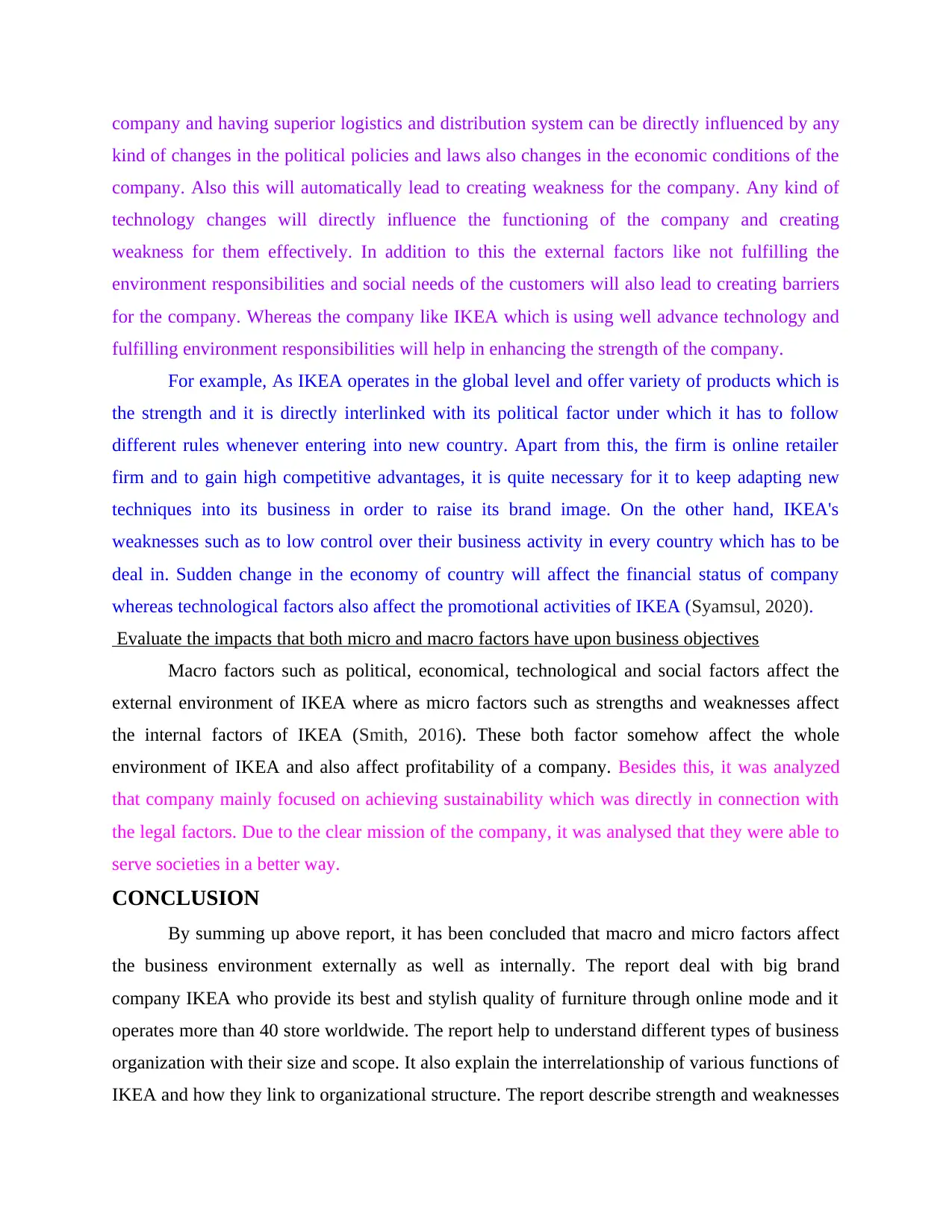
company and having superior logistics and distribution system can be directly influenced by any
kind of changes in the political policies and laws also changes in the economic conditions of the
company. Also this will automatically lead to creating weakness for the company. Any kind of
technology changes will directly influence the functioning of the company and creating
weakness for them effectively. In addition to this the external factors like not fulfilling the
environment responsibilities and social needs of the customers will also lead to creating barriers
for the company. Whereas the company like IKEA which is using well advance technology and
fulfilling environment responsibilities will help in enhancing the strength of the company.
For example, As IKEA operates in the global level and offer variety of products which is
the strength and it is directly interlinked with its political factor under which it has to follow
different rules whenever entering into new country. Apart from this, the firm is online retailer
firm and to gain high competitive advantages, it is quite necessary for it to keep adapting new
techniques into its business in order to raise its brand image. On the other hand, IKEA's
weaknesses such as to low control over their business activity in every country which has to be
deal in. Sudden change in the economy of country will affect the financial status of company
whereas technological factors also affect the promotional activities of IKEA (Syamsul, 2020).
Evaluate the impacts that both micro and macro factors have upon business objectives
Macro factors such as political, economical, technological and social factors affect the
external environment of IKEA where as micro factors such as strengths and weaknesses affect
the internal factors of IKEA (Smith, 2016). These both factor somehow affect the whole
environment of IKEA and also affect profitability of a company. Besides this, it was analyzed
that company mainly focused on achieving sustainability which was directly in connection with
the legal factors. Due to the clear mission of the company, it was analysed that they were able to
serve societies in a better way.
CONCLUSION
By summing up above report, it has been concluded that macro and micro factors affect
the business environment externally as well as internally. The report deal with big brand
company IKEA who provide its best and stylish quality of furniture through online mode and it
operates more than 40 store worldwide. The report help to understand different types of business
organization with their size and scope. It also explain the interrelationship of various functions of
IKEA and how they link to organizational structure. The report describe strength and weaknesses
kind of changes in the political policies and laws also changes in the economic conditions of the
company. Also this will automatically lead to creating weakness for the company. Any kind of
technology changes will directly influence the functioning of the company and creating
weakness for them effectively. In addition to this the external factors like not fulfilling the
environment responsibilities and social needs of the customers will also lead to creating barriers
for the company. Whereas the company like IKEA which is using well advance technology and
fulfilling environment responsibilities will help in enhancing the strength of the company.
For example, As IKEA operates in the global level and offer variety of products which is
the strength and it is directly interlinked with its political factor under which it has to follow
different rules whenever entering into new country. Apart from this, the firm is online retailer
firm and to gain high competitive advantages, it is quite necessary for it to keep adapting new
techniques into its business in order to raise its brand image. On the other hand, IKEA's
weaknesses such as to low control over their business activity in every country which has to be
deal in. Sudden change in the economy of country will affect the financial status of company
whereas technological factors also affect the promotional activities of IKEA (Syamsul, 2020).
Evaluate the impacts that both micro and macro factors have upon business objectives
Macro factors such as political, economical, technological and social factors affect the
external environment of IKEA where as micro factors such as strengths and weaknesses affect
the internal factors of IKEA (Smith, 2016). These both factor somehow affect the whole
environment of IKEA and also affect profitability of a company. Besides this, it was analyzed
that company mainly focused on achieving sustainability which was directly in connection with
the legal factors. Due to the clear mission of the company, it was analysed that they were able to
serve societies in a better way.
CONCLUSION
By summing up above report, it has been concluded that macro and micro factors affect
the business environment externally as well as internally. The report deal with big brand
company IKEA who provide its best and stylish quality of furniture through online mode and it
operates more than 40 store worldwide. The report help to understand different types of business
organization with their size and scope. It also explain the interrelationship of various functions of
IKEA and how they link to organizational structure. The report describe strength and weaknesses
Secure Best Marks with AI Grader
Need help grading? Try our AI Grader for instant feedback on your assignments.
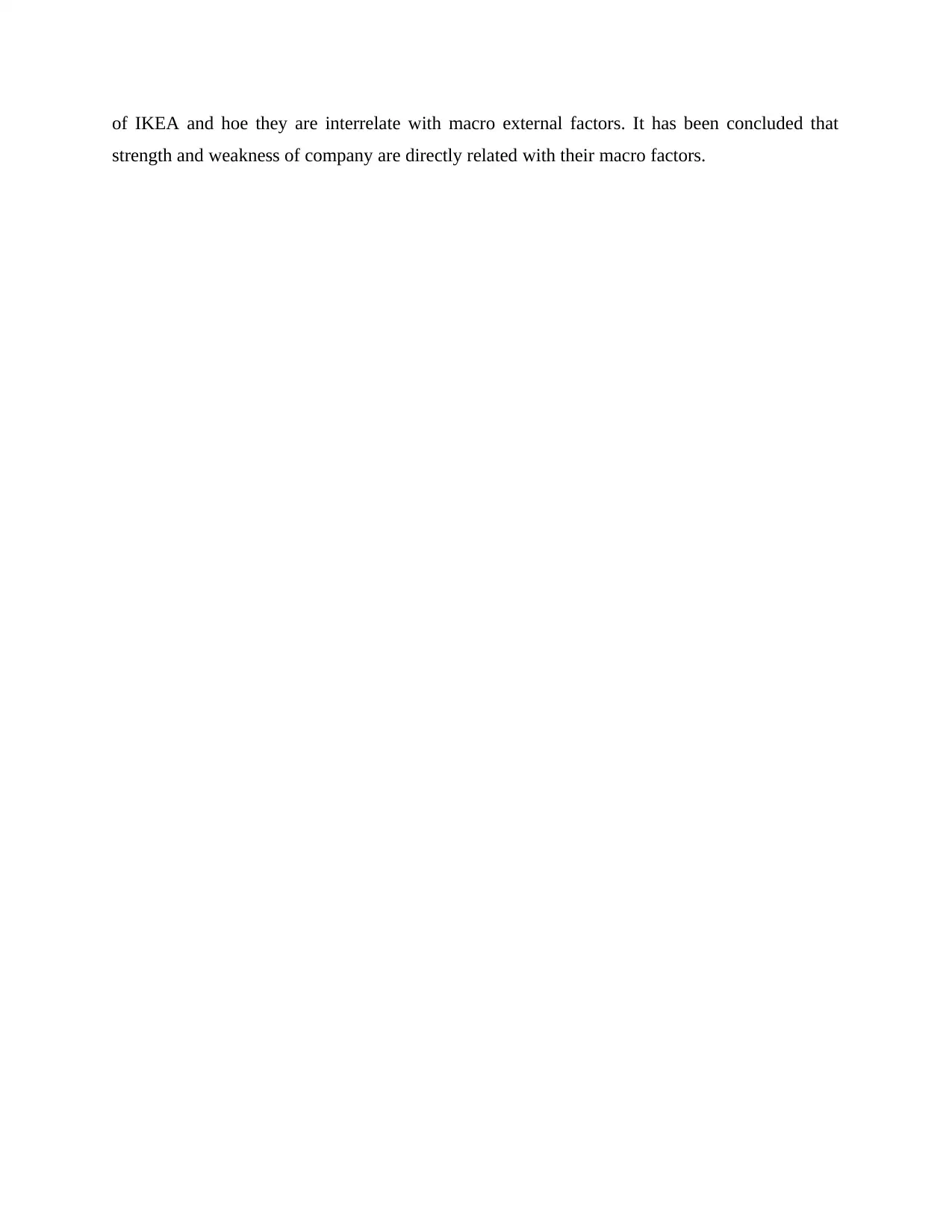
of IKEA and hoe they are interrelate with macro external factors. It has been concluded that
strength and weakness of company are directly related with their macro factors.
strength and weakness of company are directly related with their macro factors.
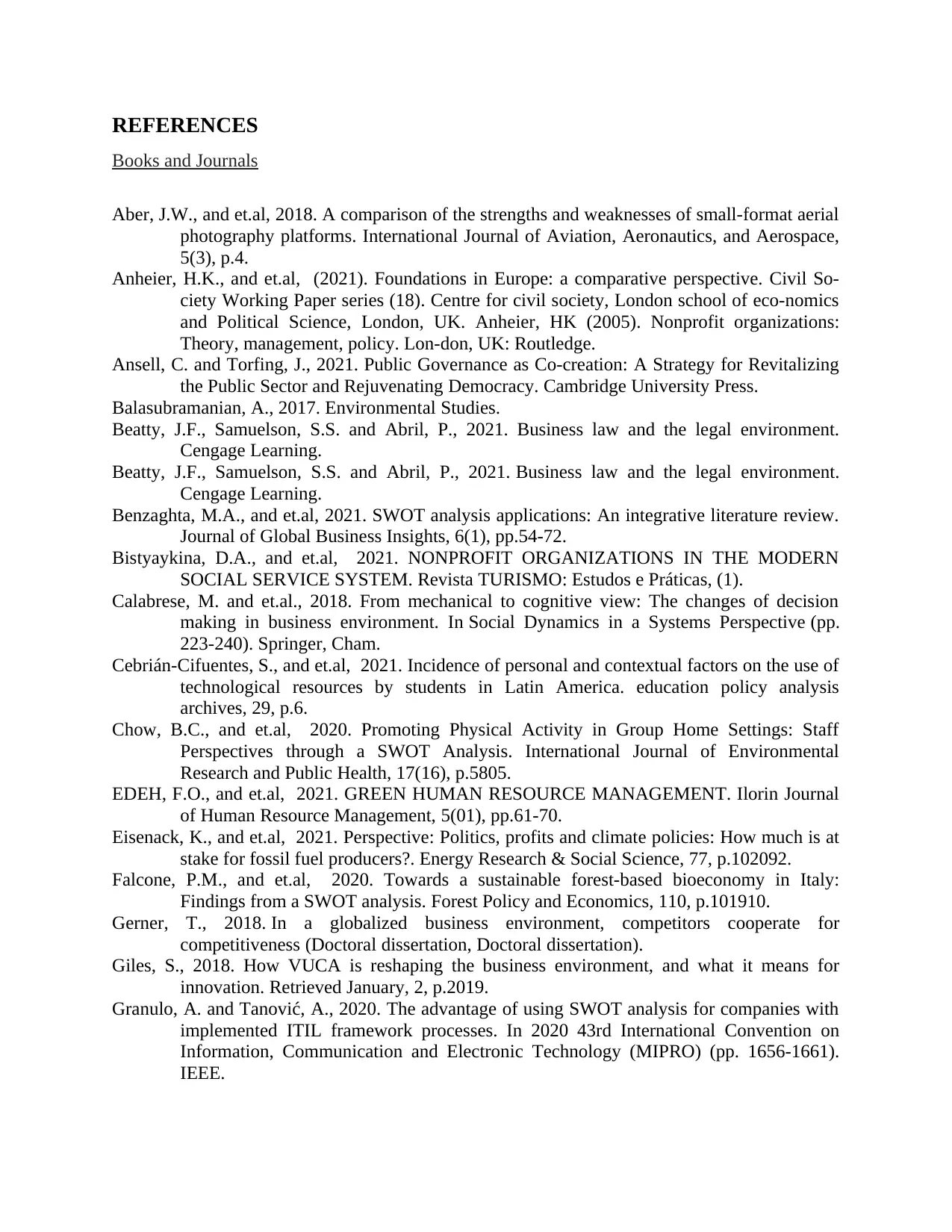
REFERENCES
Books and Journals
Aber, J.W., and et.al, 2018. A comparison of the strengths and weaknesses of small-format aerial
photography platforms. International Journal of Aviation, Aeronautics, and Aerospace,
5(3), p.4.
Anheier, H.K., and et.al, (2021). Foundations in Europe: a comparative perspective. Civil So-
ciety Working Paper series (18). Centre for civil society, London school of eco-nomics
and Political Science, London, UK. Anheier, HK (2005). Nonprofit organizations:
Theory, management, policy. Lon-don, UK: Routledge.
Ansell, C. and Torfing, J., 2021. Public Governance as Co-creation: A Strategy for Revitalizing
the Public Sector and Rejuvenating Democracy. Cambridge University Press.
Balasubramanian, A., 2017. Environmental Studies.
Beatty, J.F., Samuelson, S.S. and Abril, P., 2021. Business law and the legal environment.
Cengage Learning.
Beatty, J.F., Samuelson, S.S. and Abril, P., 2021. Business law and the legal environment.
Cengage Learning.
Benzaghta, M.A., and et.al, 2021. SWOT analysis applications: An integrative literature review.
Journal of Global Business Insights, 6(1), pp.54-72.
Bistyaykina, D.A., and et.al, 2021. NONPROFIT ORGANIZATIONS IN THE MODERN
SOCIAL SERVICE SYSTEM. Revista TURISMO: Estudos e Práticas, (1).
Calabrese, M. and et.al., 2018. From mechanical to cognitive view: The changes of decision
making in business environment. In Social Dynamics in a Systems Perspective (pp.
223-240). Springer, Cham.
Cebrián-Cifuentes, S., and et.al, 2021. Incidence of personal and contextual factors on the use of
technological resources by students in Latin America. education policy analysis
archives, 29, p.6.
Chow, B.C., and et.al, 2020. Promoting Physical Activity in Group Home Settings: Staff
Perspectives through a SWOT Analysis. International Journal of Environmental
Research and Public Health, 17(16), p.5805.
EDEH, F.O., and et.al, 2021. GREEN HUMAN RESOURCE MANAGEMENT. Ilorin Journal
of Human Resource Management, 5(01), pp.61-70.
Eisenack, K., and et.al, 2021. Perspective: Politics, profits and climate policies: How much is at
stake for fossil fuel producers?. Energy Research & Social Science, 77, p.102092.
Falcone, P.M., and et.al, 2020. Towards a sustainable forest-based bioeconomy in Italy:
Findings from a SWOT analysis. Forest Policy and Economics, 110, p.101910.
Gerner, T., 2018. In a globalized business environment, competitors cooperate for
competitiveness (Doctoral dissertation, Doctoral dissertation).
Giles, S., 2018. How VUCA is reshaping the business environment, and what it means for
innovation. Retrieved January, 2, p.2019.
Granulo, A. and Tanović, A., 2020. The advantage of using SWOT analysis for companies with
implemented ITIL framework processes. In 2020 43rd International Convention on
Information, Communication and Electronic Technology (MIPRO) (pp. 1656-1661).
IEEE.
Books and Journals
Aber, J.W., and et.al, 2018. A comparison of the strengths and weaknesses of small-format aerial
photography platforms. International Journal of Aviation, Aeronautics, and Aerospace,
5(3), p.4.
Anheier, H.K., and et.al, (2021). Foundations in Europe: a comparative perspective. Civil So-
ciety Working Paper series (18). Centre for civil society, London school of eco-nomics
and Political Science, London, UK. Anheier, HK (2005). Nonprofit organizations:
Theory, management, policy. Lon-don, UK: Routledge.
Ansell, C. and Torfing, J., 2021. Public Governance as Co-creation: A Strategy for Revitalizing
the Public Sector and Rejuvenating Democracy. Cambridge University Press.
Balasubramanian, A., 2017. Environmental Studies.
Beatty, J.F., Samuelson, S.S. and Abril, P., 2021. Business law and the legal environment.
Cengage Learning.
Beatty, J.F., Samuelson, S.S. and Abril, P., 2021. Business law and the legal environment.
Cengage Learning.
Benzaghta, M.A., and et.al, 2021. SWOT analysis applications: An integrative literature review.
Journal of Global Business Insights, 6(1), pp.54-72.
Bistyaykina, D.A., and et.al, 2021. NONPROFIT ORGANIZATIONS IN THE MODERN
SOCIAL SERVICE SYSTEM. Revista TURISMO: Estudos e Práticas, (1).
Calabrese, M. and et.al., 2018. From mechanical to cognitive view: The changes of decision
making in business environment. In Social Dynamics in a Systems Perspective (pp.
223-240). Springer, Cham.
Cebrián-Cifuentes, S., and et.al, 2021. Incidence of personal and contextual factors on the use of
technological resources by students in Latin America. education policy analysis
archives, 29, p.6.
Chow, B.C., and et.al, 2020. Promoting Physical Activity in Group Home Settings: Staff
Perspectives through a SWOT Analysis. International Journal of Environmental
Research and Public Health, 17(16), p.5805.
EDEH, F.O., and et.al, 2021. GREEN HUMAN RESOURCE MANAGEMENT. Ilorin Journal
of Human Resource Management, 5(01), pp.61-70.
Eisenack, K., and et.al, 2021. Perspective: Politics, profits and climate policies: How much is at
stake for fossil fuel producers?. Energy Research & Social Science, 77, p.102092.
Falcone, P.M., and et.al, 2020. Towards a sustainable forest-based bioeconomy in Italy:
Findings from a SWOT analysis. Forest Policy and Economics, 110, p.101910.
Gerner, T., 2018. In a globalized business environment, competitors cooperate for
competitiveness (Doctoral dissertation, Doctoral dissertation).
Giles, S., 2018. How VUCA is reshaping the business environment, and what it means for
innovation. Retrieved January, 2, p.2019.
Granulo, A. and Tanović, A., 2020. The advantage of using SWOT analysis for companies with
implemented ITIL framework processes. In 2020 43rd International Convention on
Information, Communication and Electronic Technology (MIPRO) (pp. 1656-1661).
IEEE.
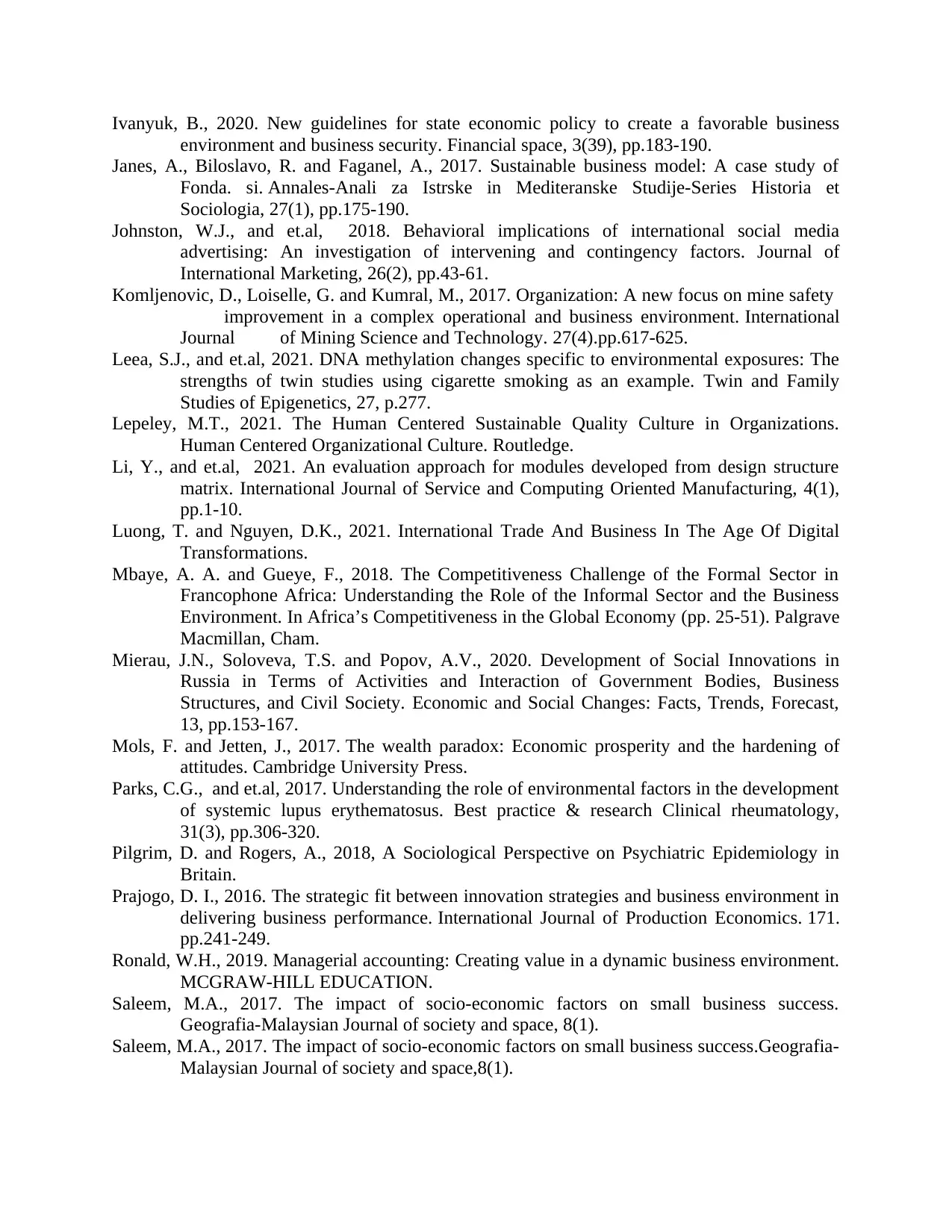
Ivanyuk, B., 2020. New guidelines for state economic policy to create a favorable business
environment and business security. Financial space, 3(39), pp.183-190.
Janes, A., Biloslavo, R. and Faganel, A., 2017. Sustainable business model: A case study of
Fonda. si. Annales-Anali za Istrske in Mediteranske Studije-Series Historia et
Sociologia, 27(1), pp.175-190.
Johnston, W.J., and et.al, 2018. Behavioral implications of international social media
advertising: An investigation of intervening and contingency factors. Journal of
International Marketing, 26(2), pp.43-61.
Komljenovic, D., Loiselle, G. and Kumral, M., 2017. Organization: A new focus on mine safety
improvement in a complex operational and business environment. International
Journal of Mining Science and Technology. 27(4).pp.617-625.
Leea, S.J., and et.al, 2021. DNA methylation changes specific to environmental exposures: The
strengths of twin studies using cigarette smoking as an example. Twin and Family
Studies of Epigenetics, 27, p.277.
Lepeley, M.T., 2021. The Human Centered Sustainable Quality Culture in Organizations.
Human Centered Organizational Culture. Routledge.
Li, Y., and et.al, 2021. An evaluation approach for modules developed from design structure
matrix. International Journal of Service and Computing Oriented Manufacturing, 4(1),
pp.1-10.
Luong, T. and Nguyen, D.K., 2021. International Trade And Business In The Age Of Digital
Transformations.
Mbaye, A. A. and Gueye, F., 2018. The Competitiveness Challenge of the Formal Sector in
Francophone Africa: Understanding the Role of the Informal Sector and the Business
Environment. In Africa’s Competitiveness in the Global Economy (pp. 25-51). Palgrave
Macmillan, Cham.
Mierau, J.N., Soloveva, T.S. and Popov, A.V., 2020. Development of Social Innovations in
Russia in Terms of Activities and Interaction of Government Bodies, Business
Structures, and Civil Society. Economic and Social Changes: Facts, Trends, Forecast,
13, pp.153-167.
Mols, F. and Jetten, J., 2017. The wealth paradox: Economic prosperity and the hardening of
attitudes. Cambridge University Press.
Parks, C.G., and et.al, 2017. Understanding the role of environmental factors in the development
of systemic lupus erythematosus. Best practice & research Clinical rheumatology,
31(3), pp.306-320.
Pilgrim, D. and Rogers, A., 2018, A Sociological Perspective on Psychiatric Epidemiology in
Britain.
Prajogo, D. I., 2016. The strategic fit between innovation strategies and business environment in
delivering business performance. International Journal of Production Economics. 171.
pp.241-249.
Ronald, W.H., 2019. Managerial accounting: Creating value in a dynamic business environment.
MCGRAW-HILL EDUCATION.
Saleem, M.A., 2017. The impact of socio-economic factors on small business success.
Geografia-Malaysian Journal of society and space, 8(1).
Saleem, M.A., 2017. The impact of socio-economic factors on small business success.Geografia-
Malaysian Journal of society and space,8(1).
environment and business security. Financial space, 3(39), pp.183-190.
Janes, A., Biloslavo, R. and Faganel, A., 2017. Sustainable business model: A case study of
Fonda. si. Annales-Anali za Istrske in Mediteranske Studije-Series Historia et
Sociologia, 27(1), pp.175-190.
Johnston, W.J., and et.al, 2018. Behavioral implications of international social media
advertising: An investigation of intervening and contingency factors. Journal of
International Marketing, 26(2), pp.43-61.
Komljenovic, D., Loiselle, G. and Kumral, M., 2017. Organization: A new focus on mine safety
improvement in a complex operational and business environment. International
Journal of Mining Science and Technology. 27(4).pp.617-625.
Leea, S.J., and et.al, 2021. DNA methylation changes specific to environmental exposures: The
strengths of twin studies using cigarette smoking as an example. Twin and Family
Studies of Epigenetics, 27, p.277.
Lepeley, M.T., 2021. The Human Centered Sustainable Quality Culture in Organizations.
Human Centered Organizational Culture. Routledge.
Li, Y., and et.al, 2021. An evaluation approach for modules developed from design structure
matrix. International Journal of Service and Computing Oriented Manufacturing, 4(1),
pp.1-10.
Luong, T. and Nguyen, D.K., 2021. International Trade And Business In The Age Of Digital
Transformations.
Mbaye, A. A. and Gueye, F., 2018. The Competitiveness Challenge of the Formal Sector in
Francophone Africa: Understanding the Role of the Informal Sector and the Business
Environment. In Africa’s Competitiveness in the Global Economy (pp. 25-51). Palgrave
Macmillan, Cham.
Mierau, J.N., Soloveva, T.S. and Popov, A.V., 2020. Development of Social Innovations in
Russia in Terms of Activities and Interaction of Government Bodies, Business
Structures, and Civil Society. Economic and Social Changes: Facts, Trends, Forecast,
13, pp.153-167.
Mols, F. and Jetten, J., 2017. The wealth paradox: Economic prosperity and the hardening of
attitudes. Cambridge University Press.
Parks, C.G., and et.al, 2017. Understanding the role of environmental factors in the development
of systemic lupus erythematosus. Best practice & research Clinical rheumatology,
31(3), pp.306-320.
Pilgrim, D. and Rogers, A., 2018, A Sociological Perspective on Psychiatric Epidemiology in
Britain.
Prajogo, D. I., 2016. The strategic fit between innovation strategies and business environment in
delivering business performance. International Journal of Production Economics. 171.
pp.241-249.
Ronald, W.H., 2019. Managerial accounting: Creating value in a dynamic business environment.
MCGRAW-HILL EDUCATION.
Saleem, M.A., 2017. The impact of socio-economic factors on small business success.
Geografia-Malaysian Journal of society and space, 8(1).
Saleem, M.A., 2017. The impact of socio-economic factors on small business success.Geografia-
Malaysian Journal of society and space,8(1).
Paraphrase This Document
Need a fresh take? Get an instant paraphrase of this document with our AI Paraphraser
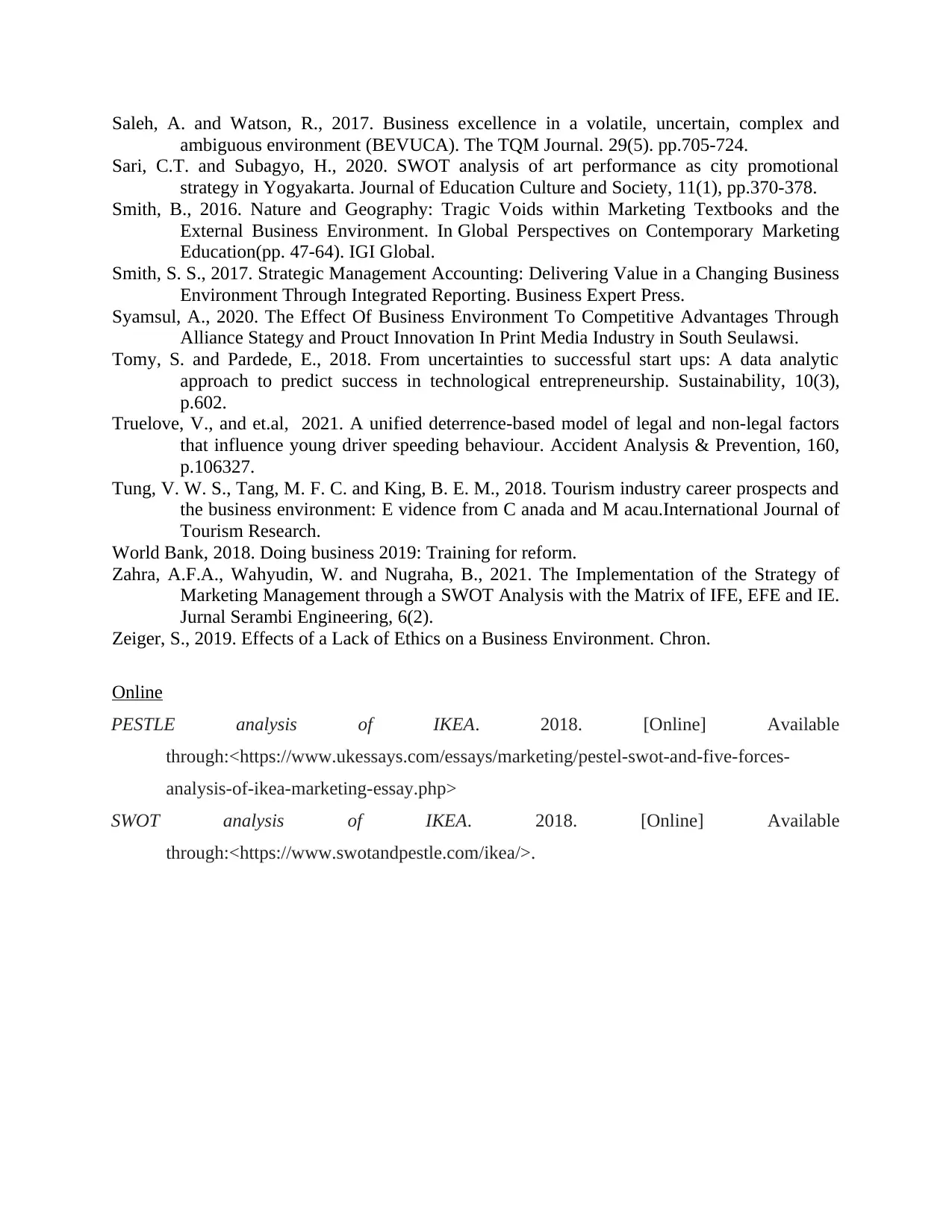
Saleh, A. and Watson, R., 2017. Business excellence in a volatile, uncertain, complex and
ambiguous environment (BEVUCA). The TQM Journal. 29(5). pp.705-724.
Sari, C.T. and Subagyo, H., 2020. SWOT analysis of art performance as city promotional
strategy in Yogyakarta. Journal of Education Culture and Society, 11(1), pp.370-378.
Smith, B., 2016. Nature and Geography: Tragic Voids within Marketing Textbooks and the
External Business Environment. In Global Perspectives on Contemporary Marketing
Education(pp. 47-64). IGI Global.
Smith, S. S., 2017. Strategic Management Accounting: Delivering Value in a Changing Business
Environment Through Integrated Reporting. Business Expert Press.
Syamsul, A., 2020. The Effect Of Business Environment To Competitive Advantages Through
Alliance Stategy and Prouct Innovation In Print Media Industry in South Seulawsi.
Tomy, S. and Pardede, E., 2018. From uncertainties to successful start ups: A data analytic
approach to predict success in technological entrepreneurship. Sustainability, 10(3),
p.602.
Truelove, V., and et.al, 2021. A unified deterrence-based model of legal and non-legal factors
that influence young driver speeding behaviour. Accident Analysis & Prevention, 160,
p.106327.
Tung, V. W. S., Tang, M. F. C. and King, B. E. M., 2018. Tourism industry career prospects and
the business environment: E vidence from C anada and M acau.International Journal of
Tourism Research.
World Bank, 2018. Doing business 2019: Training for reform.
Zahra, A.F.A., Wahyudin, W. and Nugraha, B., 2021. The Implementation of the Strategy of
Marketing Management through a SWOT Analysis with the Matrix of IFE, EFE and IE.
Jurnal Serambi Engineering, 6(2).
Zeiger, S., 2019. Effects of a Lack of Ethics on a Business Environment. Chron.
Online
PESTLE analysis of IKEA. 2018. [Online] Available
through:<https://www.ukessays.com/essays/marketing/pestel-swot-and-five-forces-
analysis-of-ikea-marketing-essay.php>
SWOT analysis of IKEA. 2018. [Online] Available
through:<https://www.swotandpestle.com/ikea/>.
ambiguous environment (BEVUCA). The TQM Journal. 29(5). pp.705-724.
Sari, C.T. and Subagyo, H., 2020. SWOT analysis of art performance as city promotional
strategy in Yogyakarta. Journal of Education Culture and Society, 11(1), pp.370-378.
Smith, B., 2016. Nature and Geography: Tragic Voids within Marketing Textbooks and the
External Business Environment. In Global Perspectives on Contemporary Marketing
Education(pp. 47-64). IGI Global.
Smith, S. S., 2017. Strategic Management Accounting: Delivering Value in a Changing Business
Environment Through Integrated Reporting. Business Expert Press.
Syamsul, A., 2020. The Effect Of Business Environment To Competitive Advantages Through
Alliance Stategy and Prouct Innovation In Print Media Industry in South Seulawsi.
Tomy, S. and Pardede, E., 2018. From uncertainties to successful start ups: A data analytic
approach to predict success in technological entrepreneurship. Sustainability, 10(3),
p.602.
Truelove, V., and et.al, 2021. A unified deterrence-based model of legal and non-legal factors
that influence young driver speeding behaviour. Accident Analysis & Prevention, 160,
p.106327.
Tung, V. W. S., Tang, M. F. C. and King, B. E. M., 2018. Tourism industry career prospects and
the business environment: E vidence from C anada and M acau.International Journal of
Tourism Research.
World Bank, 2018. Doing business 2019: Training for reform.
Zahra, A.F.A., Wahyudin, W. and Nugraha, B., 2021. The Implementation of the Strategy of
Marketing Management through a SWOT Analysis with the Matrix of IFE, EFE and IE.
Jurnal Serambi Engineering, 6(2).
Zeiger, S., 2019. Effects of a Lack of Ethics on a Business Environment. Chron.
Online
PESTLE analysis of IKEA. 2018. [Online] Available
through:<https://www.ukessays.com/essays/marketing/pestel-swot-and-five-forces-
analysis-of-ikea-marketing-essay.php>
SWOT analysis of IKEA. 2018. [Online] Available
through:<https://www.swotandpestle.com/ikea/>.
1 out of 17
![[object Object]](/_next/static/media/star-bottom.7253800d.svg)





